文章
Colorful
2017年05月23日
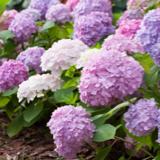
Whether you want to make an indoor garden or you already have one– Check out some of the best & most essential indoor gardening tips for help!
If you recently moved to a big city to get closer to your job or you still want to carry on farming in the dead of winter, do not fret; indoor gardening is a viable option for you. Aside from reaping a bounty harvest of your favorite vegetables, indoor gardening is suitable for growing seedlings for transplanting into a farm or continuing growth after transplanting.
Indoor plants do not require a lot of space and can survive in room corners, window sills or balconies, and they grow in containers in a process called potting. Plants emanate oxygen which in turn cleanses the air in your apartment. People who reside in industrial cities that experience constant smog rely on air conditioning to cleanse the air would appreciate a supply of natural fresh air in their apartments. Indoor plants such as a Bonsai tree provide aesthetic beauty to your home.
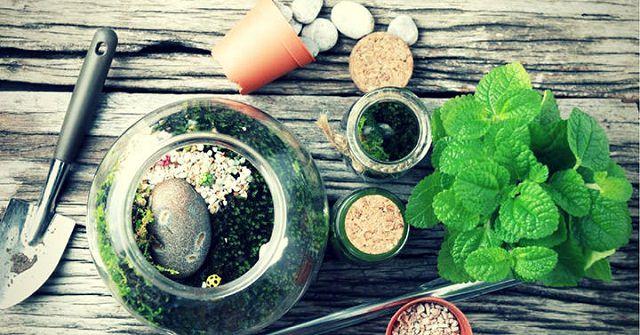
There are different species of Bonsai trees each thriving in various climatic conditions such as junipers, cedars, and pines. Bonsai trees need careful handling while styling the branches and therefore, you need to use an appropriate brush cutter to prune. For best results, seek expert advice on how to take the best care of a bonsai tree.
How do you get started?
There are some factors you need to consider before starting an indoor garden.
1. Available space
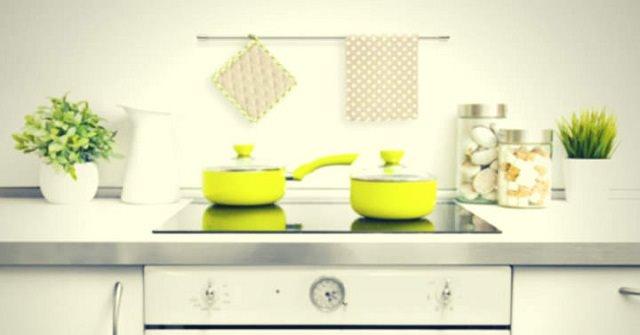
Rent in cities does not come cheap, and most city residents opt for smaller size apartments to keep living costs low. While deciding on a suitable space for indoor plants, consider access to natural light and avoid high traffic areas such as corridors or entryways. You do not want to keep bumping into potted plants or having to go around the garden each time you access the fridge. Find a reasonable place that does not hamper your movement or cause accidents especially if you have younger ones running around.
2. Growing Medium
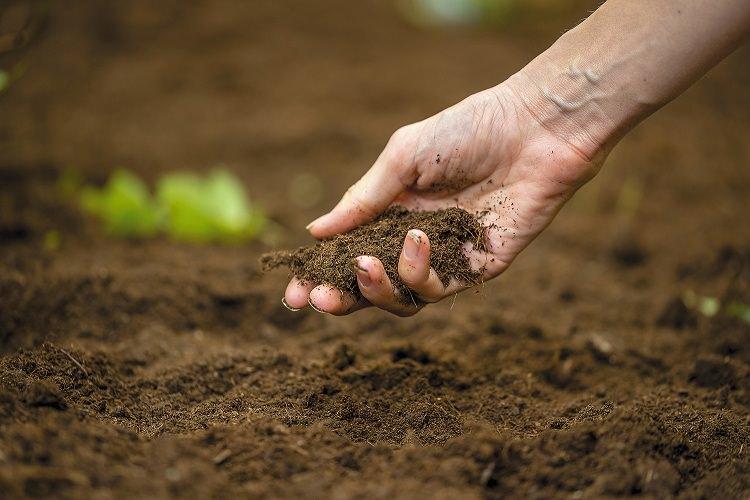
Regular garden soil is not suitable for indoor gardening as it comes with weed and all kinds of insects found on a farm. Farmland holds the plants’ roots together and provides a myriad of nutrients that are necessary for plants to thrive. You can choose to prepare a growing medium or buy a premade one at your local garden store. Potted plants dry out faster than plants growing in the soil and hence the need for a regular watering routine. Overwatering plants leads to wilting in the stems while under watering causes leaves to drop prematurely among other effects.
3. Organic nutrients
Since indoor plants do not grow in soil, you need to provide a natural boost of nutrients by applying organic fertilizer. Read the instructions on the bag to know how much fertilizer to use at a time and the frequency of application. If you are not keen on using fertilizer, you may choose to use Hydroponic nutrients or homemade compost instead.
4. Light
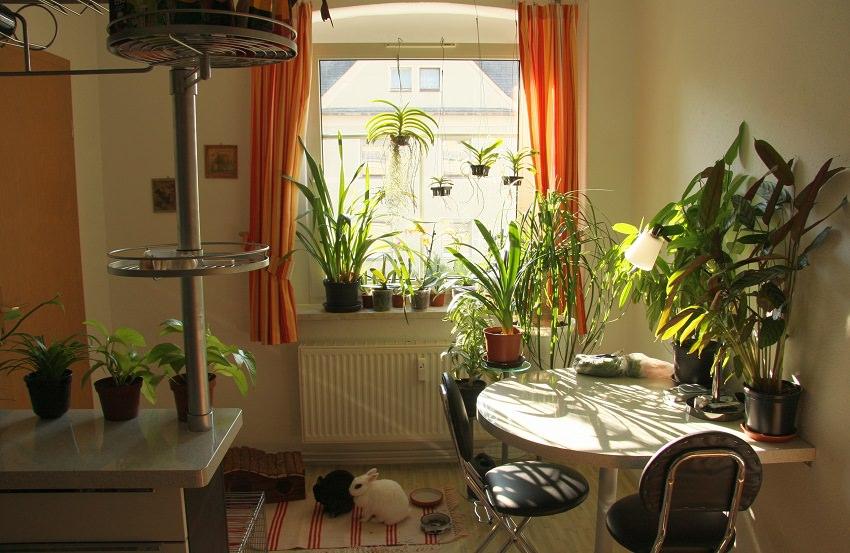
Just as nutrients are essential for the well-being of plants, so is light. Plants need light for photosynthesis which helps plants grow healthy foliage and bear fruits. Tall buildings near your apartment will obscure natural light from reaching your plants even if they are near a window. The winter season tends to be gloomy, and this means limited natural light. A grow light will solve this problem in one click of a switch. Ensure that your grow light has the same wavelength as the sun; it should not be too bright nor too dull.
5. Humidity

Lack of moisture may cause the plants to wither and lose their leaves. There are creative ways of providing enough moisture to indoor plants; try placing the plants together so they can get humidity from one another. Evaporation is an excellent source of moisture for plants. Putting a tray of water next to your plants has a similar humid effect to living near a massive water body like the sea or ocean. You can also place water next to the plants and if this does not work, invest in an environmental controller that shifts the levels of humidity as you wish.
6. Temperature
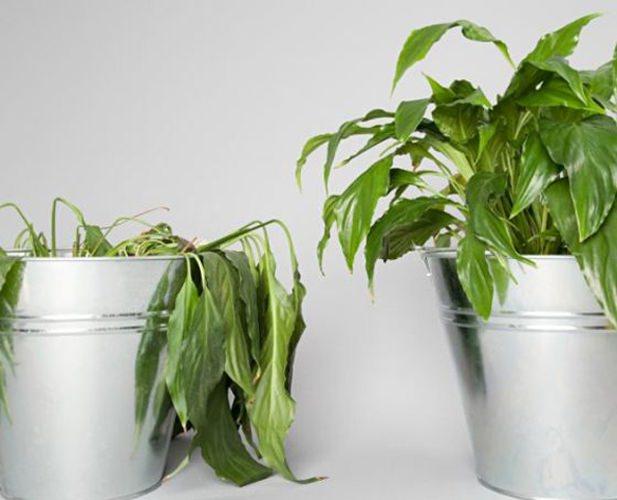
Temperatures vary from day and night and from one season to the next. Plants need correct temperatures to grow and mature. Cold temperatures may cause yellowing of leaves while hot temperatures may lead to stunted growth. Research on the right temperatures for the type of plants you want to grow in your indoor garden and adjust as required.
7. Selecting plants
After considering the fundamental elements of indoor gardening, you can now choose the type of plants you want to grow. Since space is likely to be an issue for apartment dwellers, avoid plants that grow too big as they will eat into your living space. You do not want a jungle in your home! Conventional plants for indoor gardening include flowers, herbs, fruits, bonsai trees, and vegetables.
Conclusion
Lack of land to garden should not thwart you from growing your favorite vegetables or fruit. Indoor gardening is possible in small quarters, and modern technology allows us to simulate environments that match those of a natural garden. This way, your indoor plants can have the same amount of the sunshine, water, and nutrients required to grow to maturity and harvest. Learning how to take the best care of Bonsai trees increases your chances of having these beauties grace your home.
If you recently moved to a big city to get closer to your job or you still want to carry on farming in the dead of winter, do not fret; indoor gardening is a viable option for you. Aside from reaping a bounty harvest of your favorite vegetables, indoor gardening is suitable for growing seedlings for transplanting into a farm or continuing growth after transplanting.
Indoor plants do not require a lot of space and can survive in room corners, window sills or balconies, and they grow in containers in a process called potting. Plants emanate oxygen which in turn cleanses the air in your apartment. People who reside in industrial cities that experience constant smog rely on air conditioning to cleanse the air would appreciate a supply of natural fresh air in their apartments. Indoor plants such as a Bonsai tree provide aesthetic beauty to your home.

There are different species of Bonsai trees each thriving in various climatic conditions such as junipers, cedars, and pines. Bonsai trees need careful handling while styling the branches and therefore, you need to use an appropriate brush cutter to prune. For best results, seek expert advice on how to take the best care of a bonsai tree.
How do you get started?
There are some factors you need to consider before starting an indoor garden.
1. Available space

Rent in cities does not come cheap, and most city residents opt for smaller size apartments to keep living costs low. While deciding on a suitable space for indoor plants, consider access to natural light and avoid high traffic areas such as corridors or entryways. You do not want to keep bumping into potted plants or having to go around the garden each time you access the fridge. Find a reasonable place that does not hamper your movement or cause accidents especially if you have younger ones running around.
2. Growing Medium

Regular garden soil is not suitable for indoor gardening as it comes with weed and all kinds of insects found on a farm. Farmland holds the plants’ roots together and provides a myriad of nutrients that are necessary for plants to thrive. You can choose to prepare a growing medium or buy a premade one at your local garden store. Potted plants dry out faster than plants growing in the soil and hence the need for a regular watering routine. Overwatering plants leads to wilting in the stems while under watering causes leaves to drop prematurely among other effects.
3. Organic nutrients
Since indoor plants do not grow in soil, you need to provide a natural boost of nutrients by applying organic fertilizer. Read the instructions on the bag to know how much fertilizer to use at a time and the frequency of application. If you are not keen on using fertilizer, you may choose to use Hydroponic nutrients or homemade compost instead.
4. Light

Just as nutrients are essential for the well-being of plants, so is light. Plants need light for photosynthesis which helps plants grow healthy foliage and bear fruits. Tall buildings near your apartment will obscure natural light from reaching your plants even if they are near a window. The winter season tends to be gloomy, and this means limited natural light. A grow light will solve this problem in one click of a switch. Ensure that your grow light has the same wavelength as the sun; it should not be too bright nor too dull.
5. Humidity

Lack of moisture may cause the plants to wither and lose their leaves. There are creative ways of providing enough moisture to indoor plants; try placing the plants together so they can get humidity from one another. Evaporation is an excellent source of moisture for plants. Putting a tray of water next to your plants has a similar humid effect to living near a massive water body like the sea or ocean. You can also place water next to the plants and if this does not work, invest in an environmental controller that shifts the levels of humidity as you wish.
6. Temperature

Temperatures vary from day and night and from one season to the next. Plants need correct temperatures to grow and mature. Cold temperatures may cause yellowing of leaves while hot temperatures may lead to stunted growth. Research on the right temperatures for the type of plants you want to grow in your indoor garden and adjust as required.
7. Selecting plants
After considering the fundamental elements of indoor gardening, you can now choose the type of plants you want to grow. Since space is likely to be an issue for apartment dwellers, avoid plants that grow too big as they will eat into your living space. You do not want a jungle in your home! Conventional plants for indoor gardening include flowers, herbs, fruits, bonsai trees, and vegetables.
Conclusion
Lack of land to garden should not thwart you from growing your favorite vegetables or fruit. Indoor gardening is possible in small quarters, and modern technology allows us to simulate environments that match those of a natural garden. This way, your indoor plants can have the same amount of the sunshine, water, and nutrients required to grow to maturity and harvest. Learning how to take the best care of Bonsai trees increases your chances of having these beauties grace your home.
2
2
文章
Colorful
2017年05月23日

The houseplants in this list are exceptional; they are bold and pretty. Some of the most unique, beautiful indoor plants you should grow!Grow some of these plants indoors, and you’ll see a big change in your interior. These beautiful houseplants have the ability to change the appearance of any dull-boring room!1. Nerve Plant
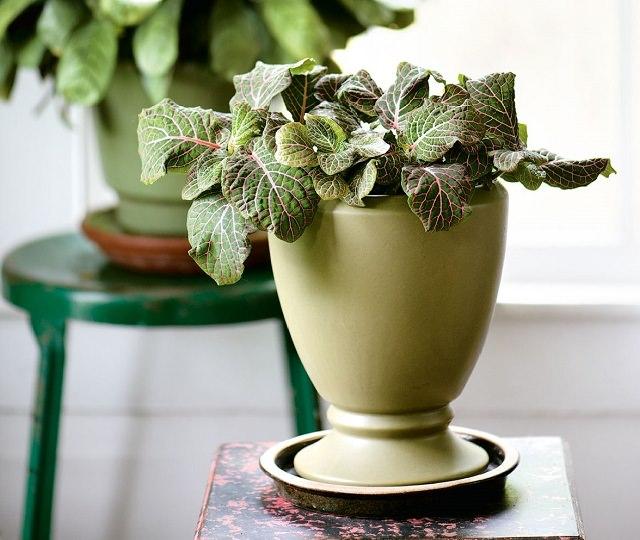
This demanding houseplant looks gorgeous due to its striking leaves. Picky about watering and dry indoor air and cold drafts. You must need to keep balance in watering.
2. Croton
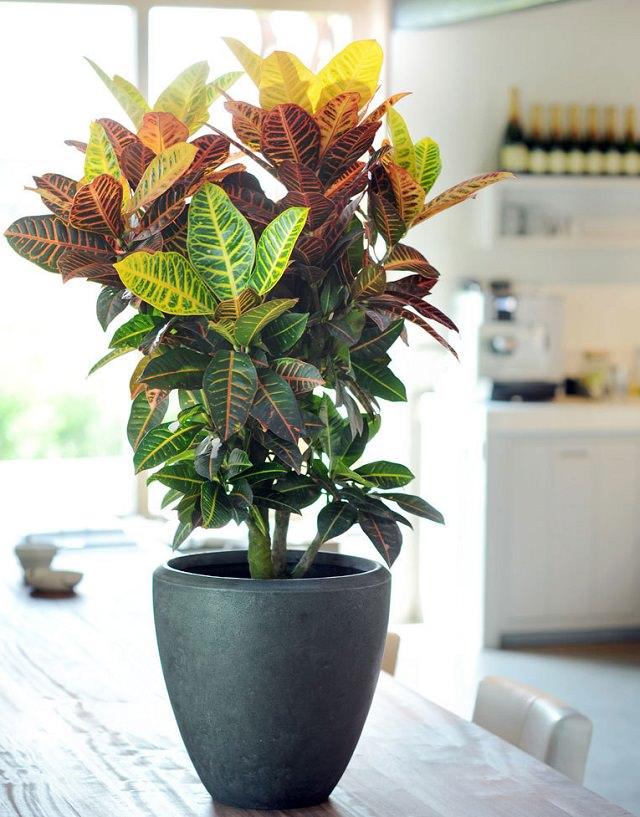
The bold and bodacious houseplant that is low maintenance too. The mix of yellow, amber, and orange color linear markings on thick dark green foliage, croton looks stunning. To grow, keep it in a spot that receives bright indirect light most of the time and water sporadically.
3. Calathea
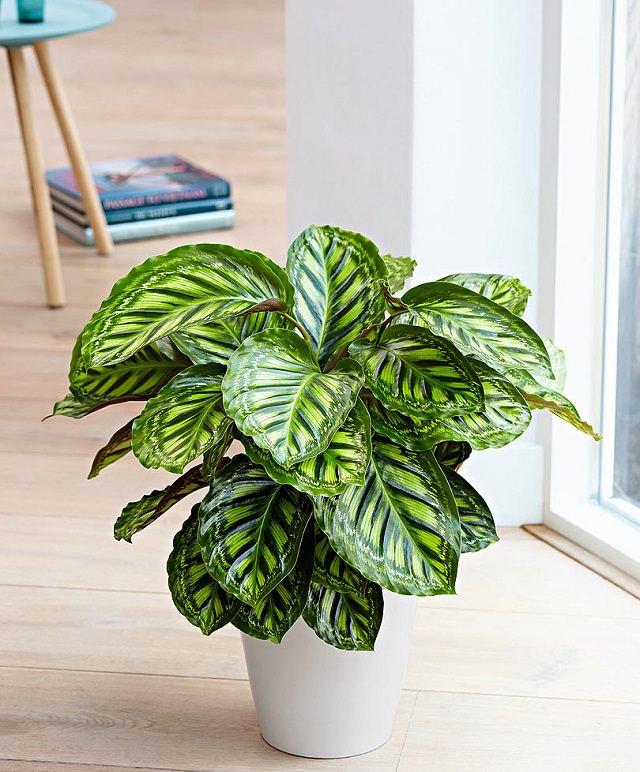
Lovely plant, great to look at! Many varieties are available in astonishing color combinations and patterns. This tropical houseplant doesn’t mind low light conditions. Keep it in warm, normal room temperature, saving from cold drafts. It likes humid surroundings and moderate watering.
4. Pencil Cactus
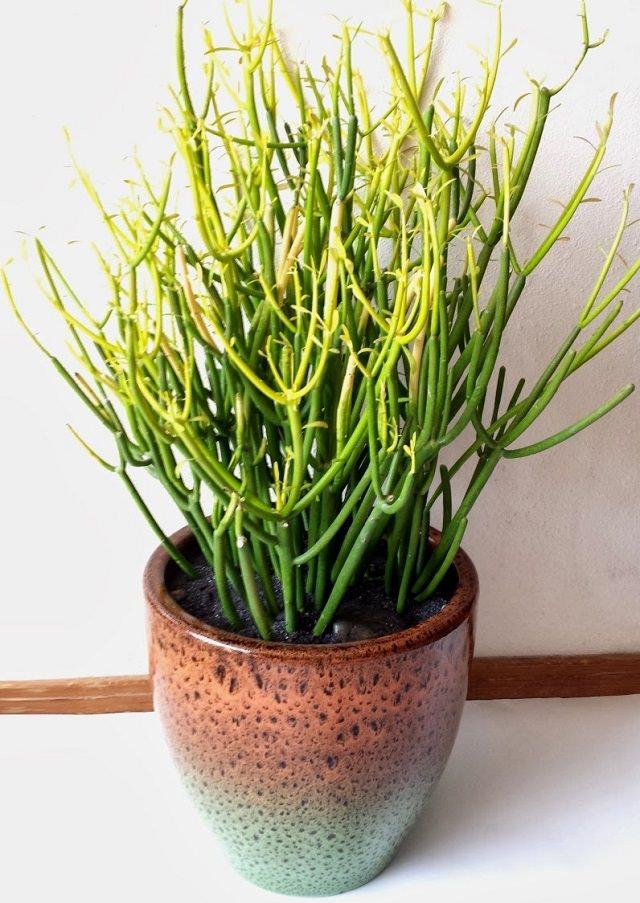
This unusual looking astonishing plant is notorious for its toxic milky sap (take care when handling this plant); still, it’s getting popular as a houseplant. Pencil cactus has medium to high light requirements and low watering needs; it also doesn’t mind dry air. Watering 2-3 times in a month is sufficient. To grow, keep the plant in a spot with ample light, a shaft of sunlight for a few hours or even more and it would do fine.
5. Silver Vase Plant
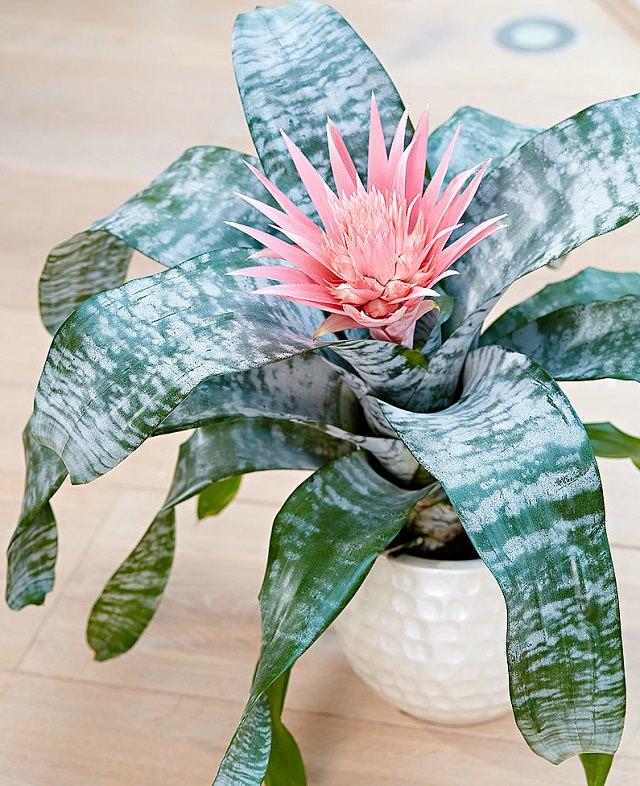
Unusual but a beautiful indoor plant, the silver vase or “urn plant” belongs to bromeliad family. Overall, growing this houseplant is similar to others– Be careful with watering, provide bright indirect light.
6. Fiddle Leaf Fig
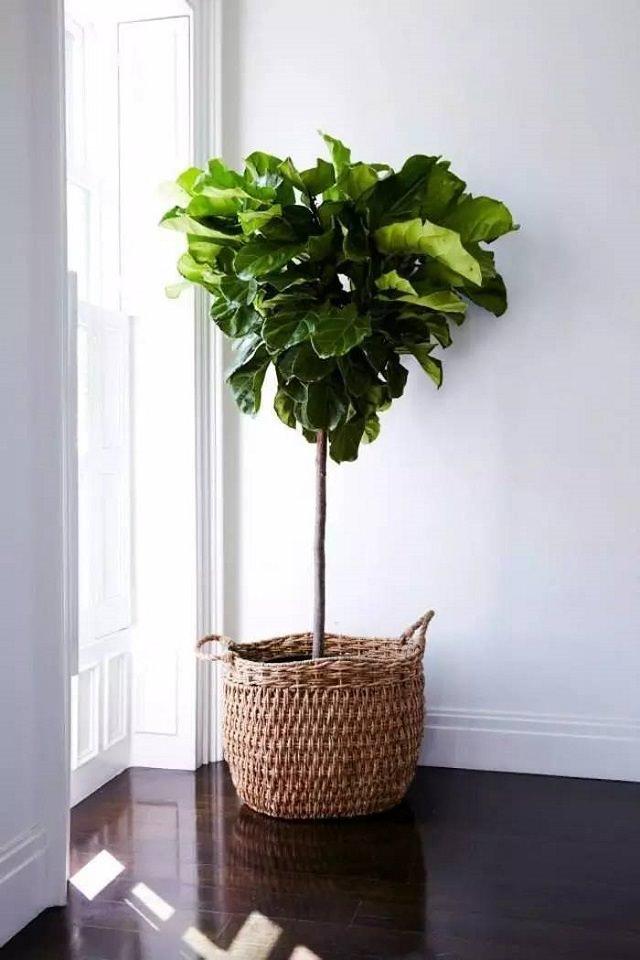
We couldn’t complete this list without adding fiddle leaf fig. Fiddle leaf is a tall, appealing houseplant with glossy, leathery foliage. This large houseplant can change the look of any room.
7. Aluminium Plant
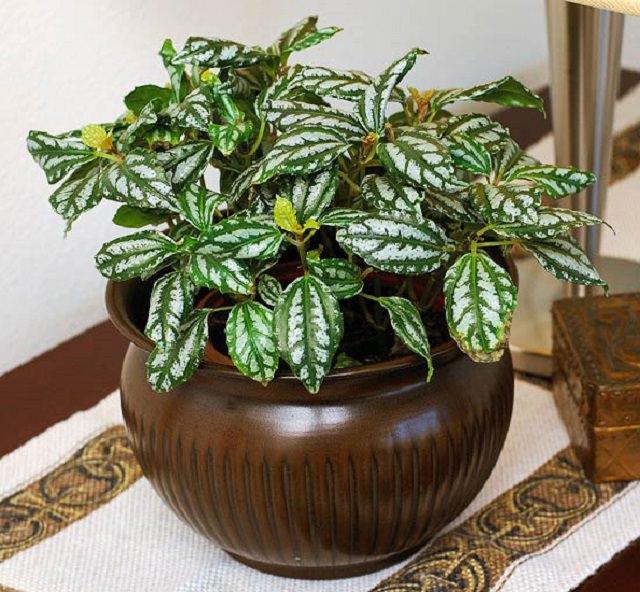
This plant is known for the beautiful silver strips that look like a color of aluminum; these strips appear over the glossy green color of each leaf. One of the beautiful indoor plants it is low maintenance. Keep it in a cool shady spot that receives a few hours of bright indirect light, water only when soil is dry.
8. Red Aglaonema
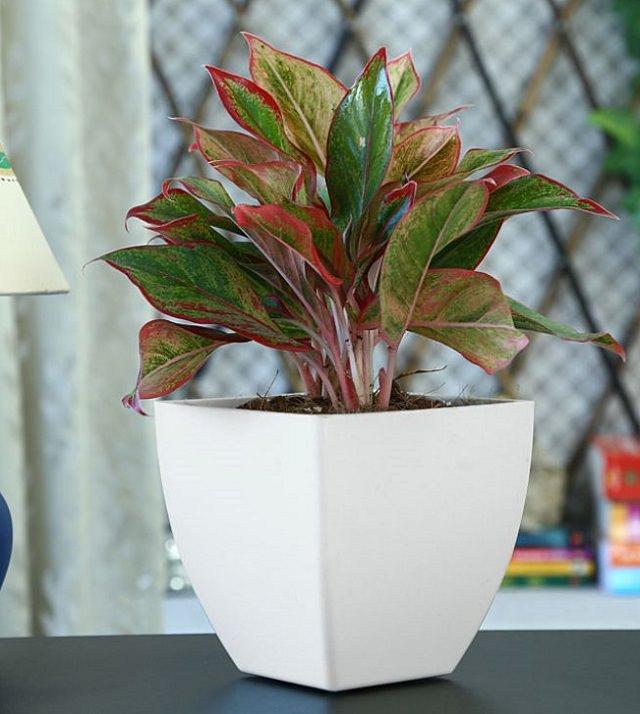
This beautiful houseplant’s dark green leaves with streaks of red and pink make it look really adorable indoors. It is absolutely easy to grow like Chinese evergreen and tolerates low light conditions and drought.
9. Anthurium
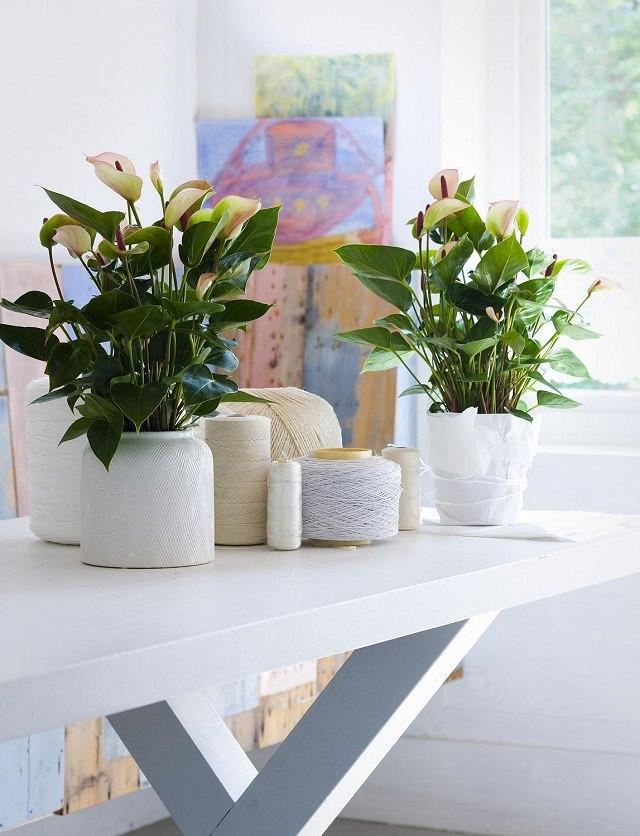
Anthuriums are beautiful houseplants that bloom in alluring shades of white, pink red or lavender. With a rich color palette, long lifespan and low care requirements, they are good for those with a busy lifestyle. Anthurium produces more foliage when grown in low-light conditions, so it’s you keep this plant in a spot that receives indirect sunlight all day.
10. African Mask Plant
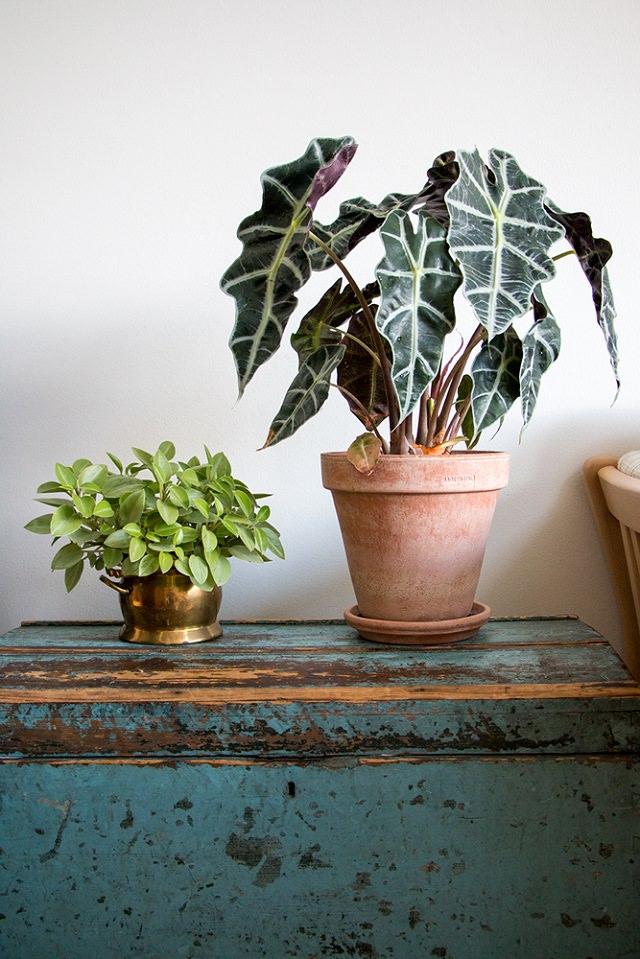
African Mask Plant with its dark green leaves and silvery-white veins can be easily mistaken for an artificial plant. This plant needs moderate watering and a bright position away from direct sunlight. Clean the leaves every few days to keep the plant looking attractive and healthy.
11. Prayer Plant
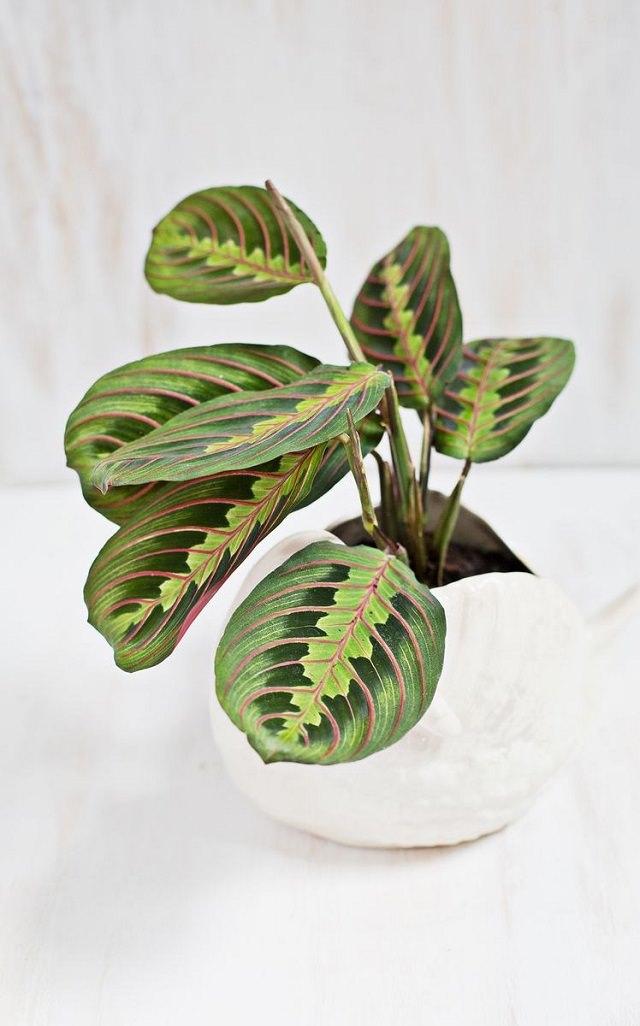
With its beautifully patterned oblong foliage and low care requirements, this exotic houseplant is a lovely addition to any home. It requires bright light, moderate watering, and warm room temperature when it’s grown indoors. One interesting fact about this houseplant is that it folds up its leaves in the night or in the dark place.
12. Bird’s Nest Fern
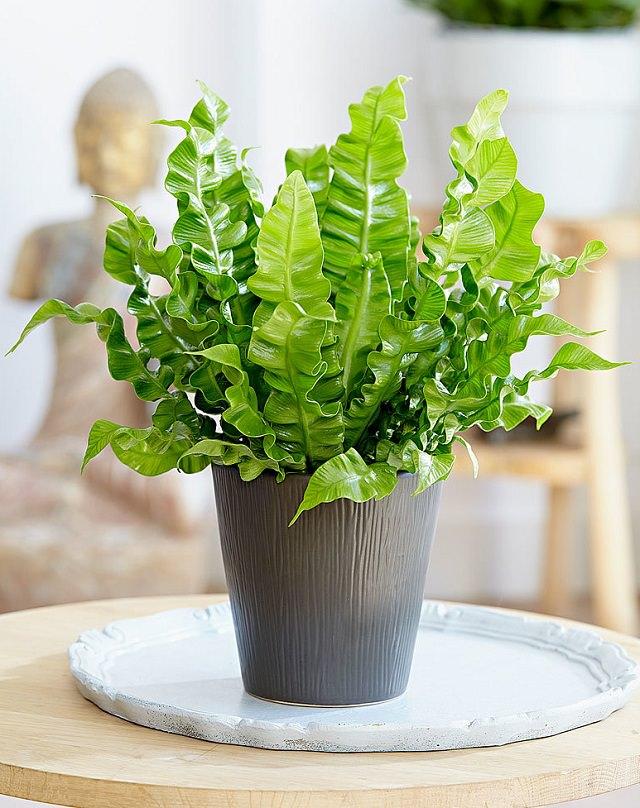
Native to Southeast Asia, bird’s nest fern (Asplenium nidus) is easy to grow if the proper conditions are given—mainly warmth and humidity. Bright indirect light and temperature around 70 F are optimum for growing bird’s nest fern indoors. Visit HGTV to learn more growing this!
13. Adenium
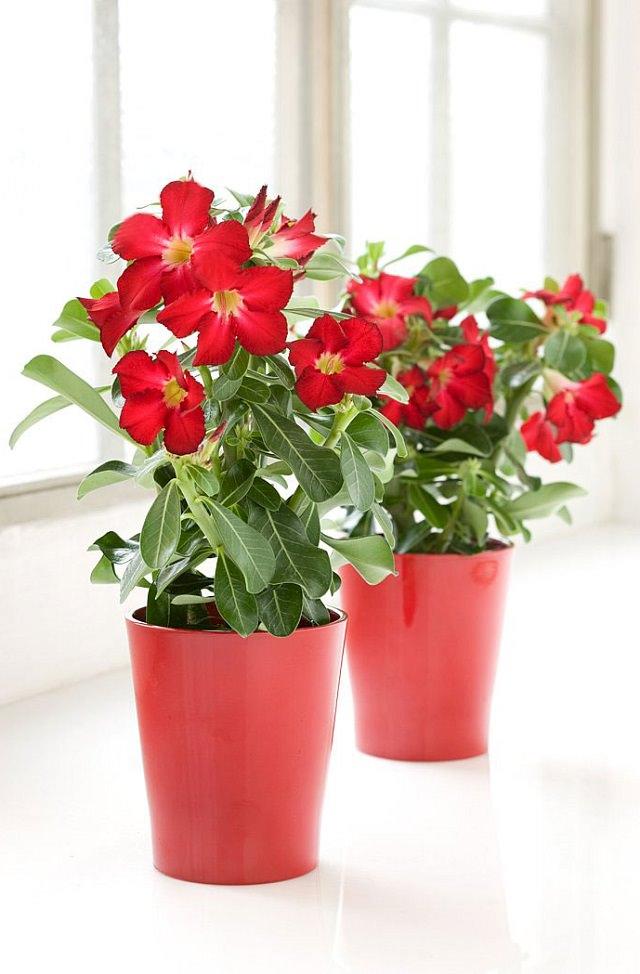
If you live in a warm climate and have a South or West facing window in your room, this is the plant you need to grow. Except for its sunlight requirements, Adenium is a low maintenance houseplant and flowers heartily throughout the year in frost-free climates.
14. Fiber-Optic Grass
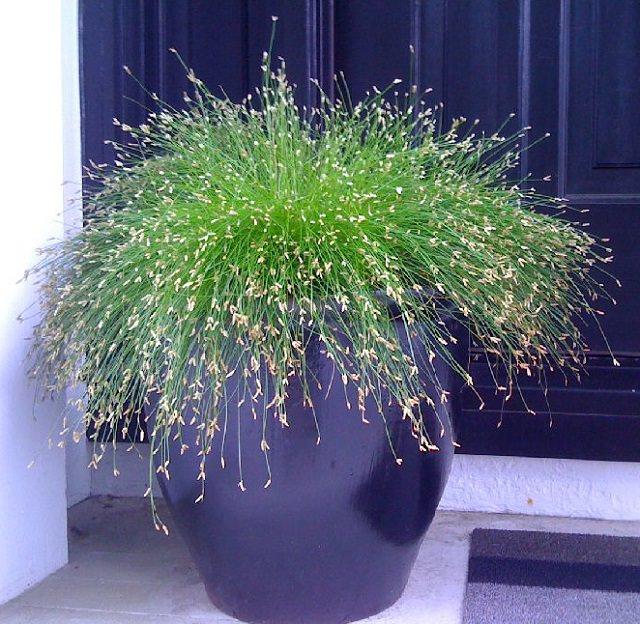
Fiber optic grass is a tropical grass that grows best in subtropical and tropical outdoor areas under USDA Zones (9-11), but it can be grown indoors in cooler regions too (We also added it to our list of BEST ORNAMENTAL GRASSES). Choose an ALLURING pot that will accentuate the beauty of this exotic grass, place it in a warm spot that receives bright light, and keep the soil slightly moist.
15. Ti Plant
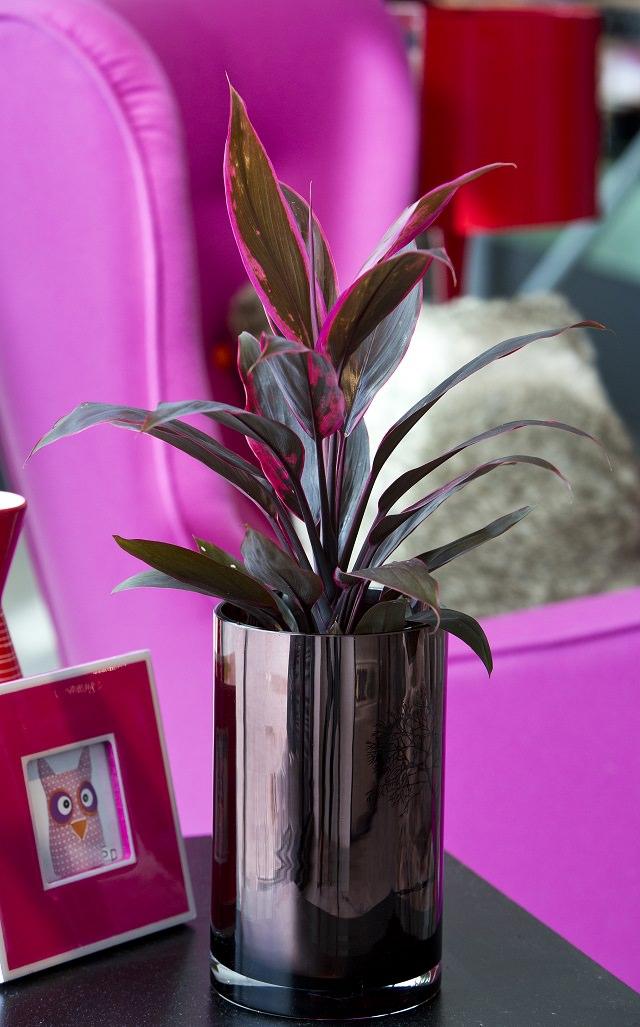
Purple foliage with streaks of blazing pink, the Ti plant looks hot and gorgeous. You can grow this plant for year around foliage attraction. This plant is drought tolerant but has a high light requirement, indoors, it must be kept somewhere where it can absorb direct and indirect light both.
16. Oxalis
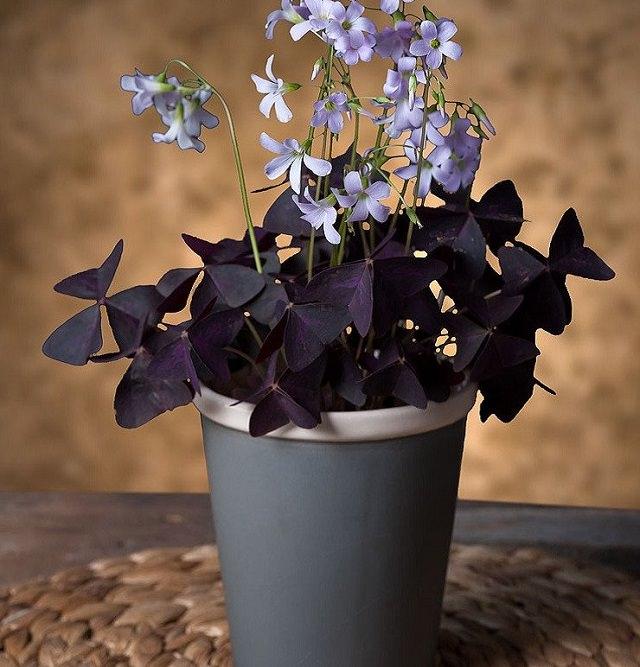
Oxalis belongs to a genus of edible, perennial plants characterized by striking mauve leaves and pink or white blooms. It prefers medium-to-bright light and performs better when grown in evenly moist soil.
17. Ponytail Palm
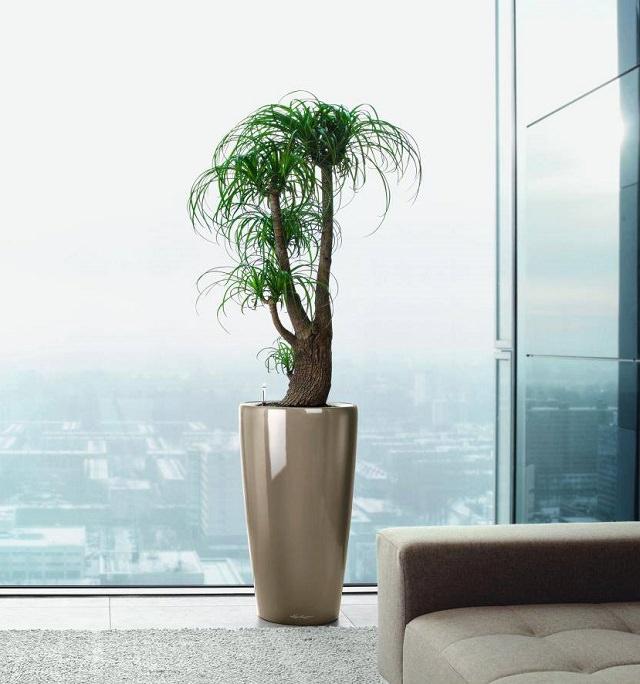
Ponytail Palm is an exotic succulent plant. It looks so interesting, one of the low maintenance plants as it has low watering needs and grows slowly, which means you don’t need to repot it frequently.
18. Poinsettia
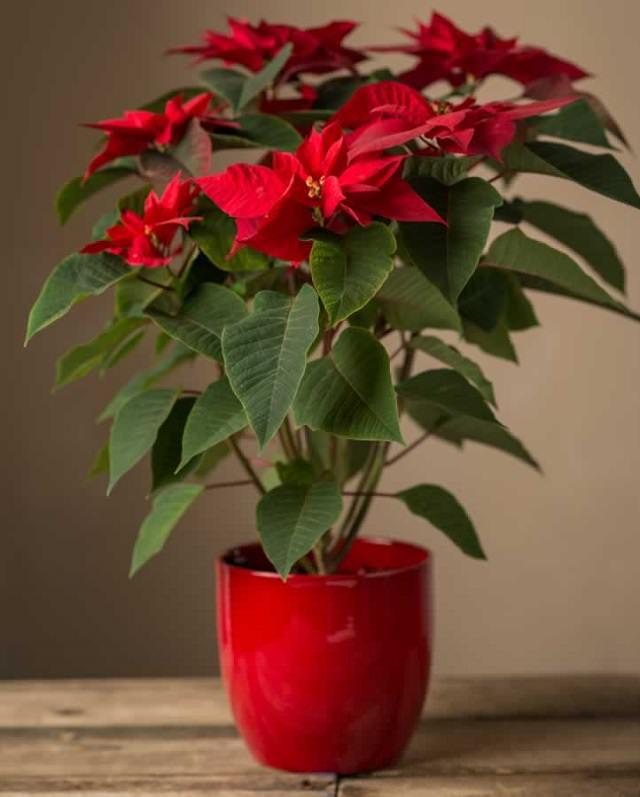
Poinsettias and holiday decorations go hand in hand. This plant looks stunning with or without blooms due to its colorful bracts and foliage. To remain healthy, cheery, and colorful, it needs a bright spot, a couple of hours of morning sunlight and indirect light all day long is sufficient. A draft-free place is best, watering when the soil is dry is required.
19. Rex Begonia
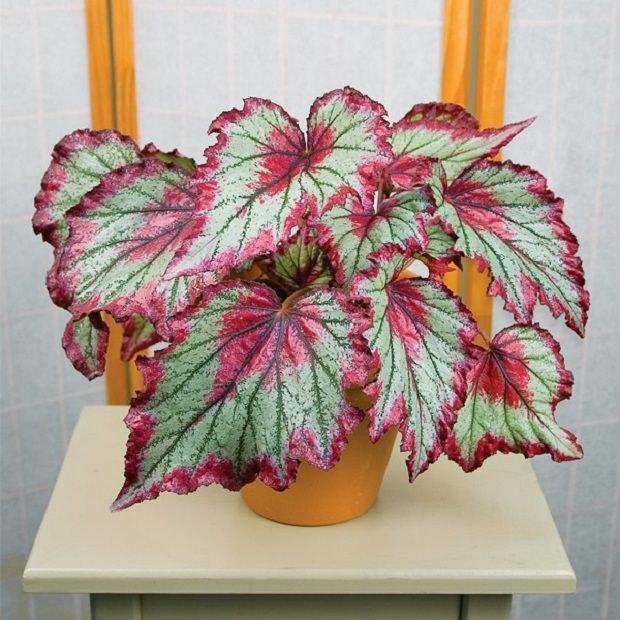
Rex begonias are best-looking begonias out there. Too showy, if you want to add a sparkle to your interior, grow them. Keeping in a bright shady spot in a well-drained medium, it’s important that you don’t overwater them.
20. Monstera Deliciosa
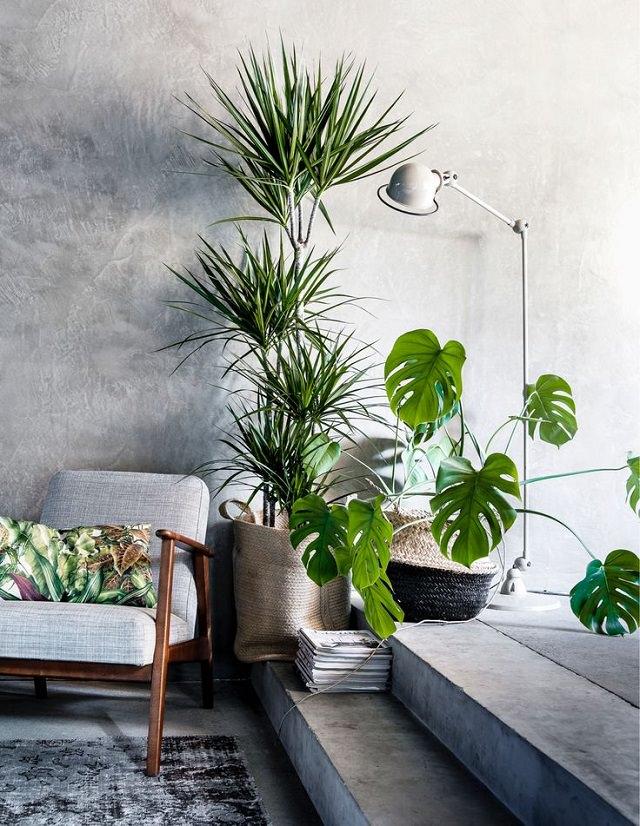
Monstera plant in a good looking pot standing beside a brightly painted wall in its supreme health displaying lush, oversized foliage of dark green color. You can imagine, it’ll look magnificent. Known as split leaf philodendron, you can also keep it in low light, for best result place it near a window where it’ll receive indirect sunlight all day long.
21. Schefflera (Umbrella Tree)
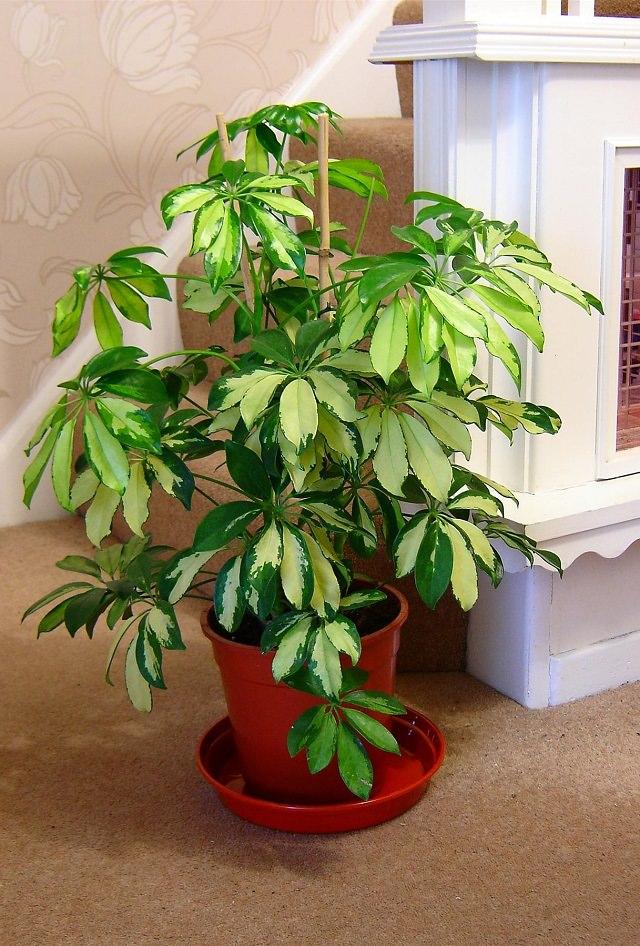
If you’re searching for a tall houseplant to improve the look of your interior, Schefflera is a good choice. Schefflera is finicky about its light requirements and doesn’t like direct sun but this doesn’t mean you can keep it in dim light, a spot near a window that receive indirect sunlight most of the time and have proper air circulation is what it demands. Watering should be done moderately.
22. Streptocarpus
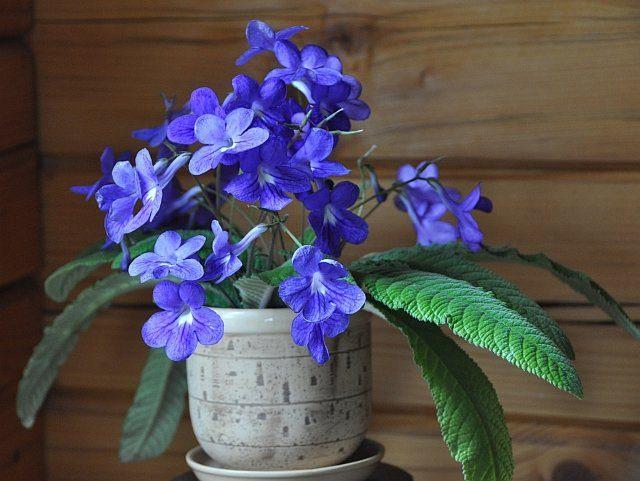
Streptocarpus, better known as the cape primrose is related to the African Violets; it prefers the same growing conditions of indirect light or filtered sunlight and moderately watered soil. Its velvety, deep green leaves and eye-catchy floral clusters hovering above the underlying foliage create a stunning appeal, which makes it perfect for adorning a secluded corner of a drawing room or adding a dash of color to an otherwise, dull space.
23. String of Pearls

The string of pearls is an easy-care succulent plant. It looks stunning in hanging baskets, trailing down. It is drought tolerant so you don’t need to water frequently, once in every other week would be enough.
24. Pleomele (Song of India)
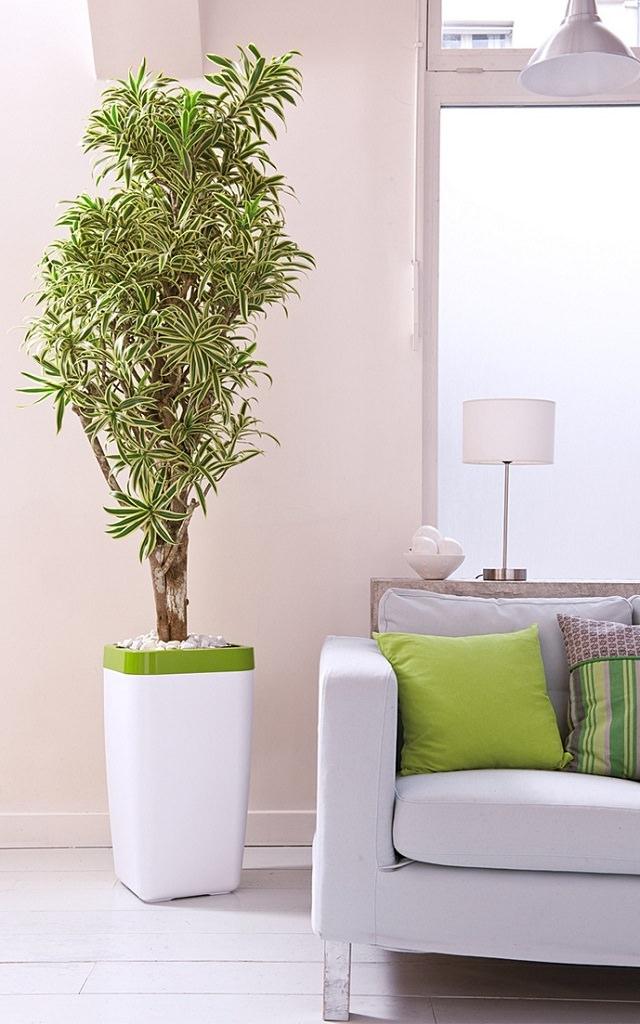
Dracaena reflexa like other plants of this genus is an easy-care houseplant. It’s one of the most ornamental dracaenas; the leaves have solid green color in the middle and a line of lime-yellow color on sides. Good for tabletops and plant stands as pleomele is a slow growing plant.
25. Brazilian Fireworks
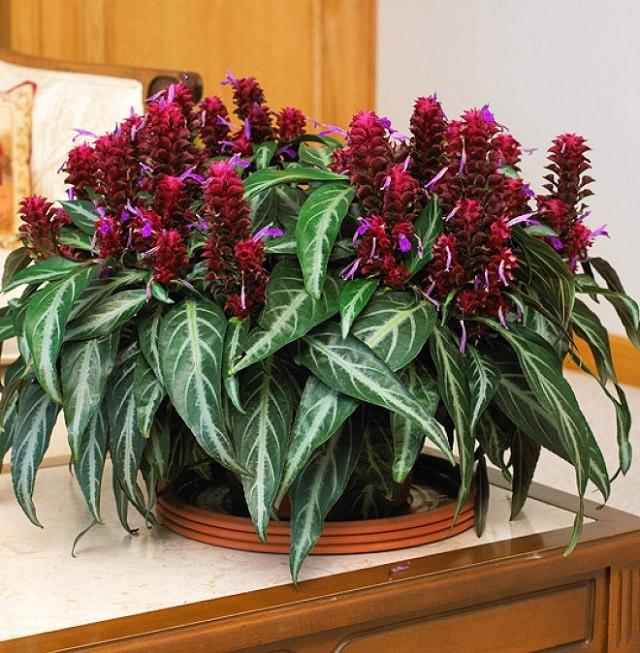
Whether you use this gorgeous tropical plant indoors, or in warm, shade gardens (if living in USDA zones 9-11), the Brazilian fireworks is a year-round delight with or without its flowers. This shade-loving plant is DEMANDING but thrives best when subjected to bright, indirect sunlight and occasional watering.
26. Peace lily
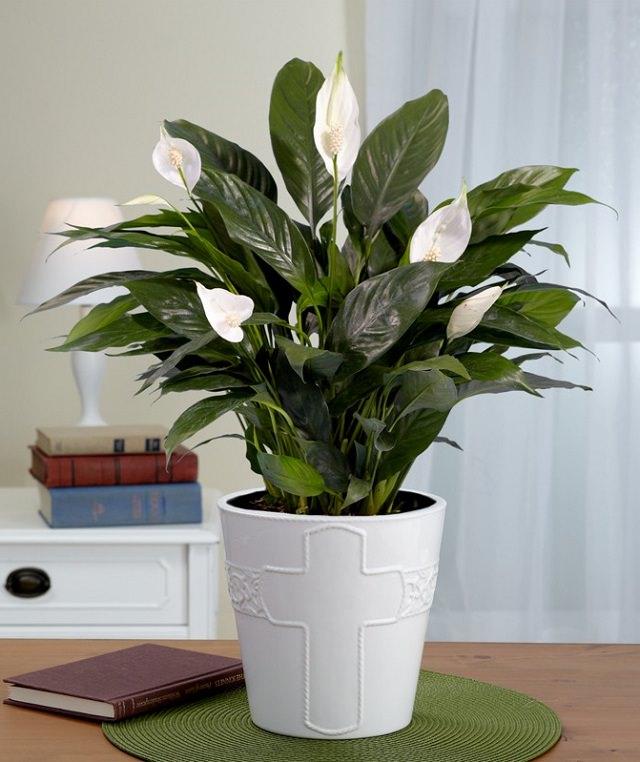
The peace lily is an attractive, low maintenance, air cleaning houseplant. This plant bears showy, spoon-shaped white spathe amidst a spike of white flower. Peace Lily survives best in a shady environment and easily tackle the absence of light.
27. Crown of Thorns
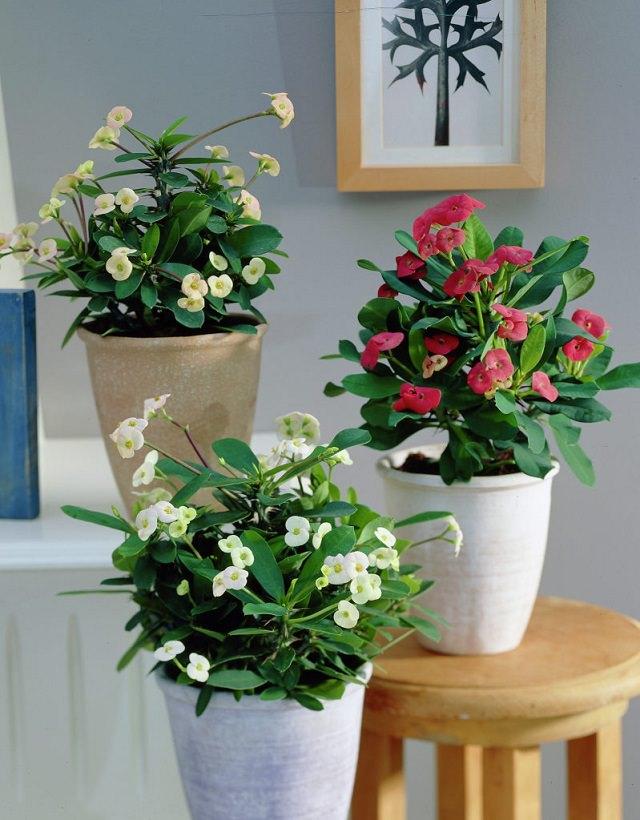
This lovely poinsettia relative is quite tolerant of neglect and thrives well as long as you place it in a bright spot and keep it in drier side. Appreciated for its showy flowers and thick, grayish-green leaves, it is a popular choice for indoor gardening.
28. Money Tree (Pachira Aquatica)

Tall, fat trunk, glossy-large foliage, the money tree is indeed a substitute for the fiddle leaf fig. Only a few indoor trees can become that tall. Also, it’s a low-maintenance houseplant. If you want to learn how to grow Pachira Aquatica indoors, click here!
29. African Violet

African violets are among the most easy-to-care flowering houseplants. They produce delicate, mauve flowers with little effort from your side. You can choose from several varieties, right from the white-edged blooms to the variegated foliage forms.

This demanding houseplant looks gorgeous due to its striking leaves. Picky about watering and dry indoor air and cold drafts. You must need to keep balance in watering.
2. Croton

The bold and bodacious houseplant that is low maintenance too. The mix of yellow, amber, and orange color linear markings on thick dark green foliage, croton looks stunning. To grow, keep it in a spot that receives bright indirect light most of the time and water sporadically.
3. Calathea

Lovely plant, great to look at! Many varieties are available in astonishing color combinations and patterns. This tropical houseplant doesn’t mind low light conditions. Keep it in warm, normal room temperature, saving from cold drafts. It likes humid surroundings and moderate watering.
4. Pencil Cactus

This unusual looking astonishing plant is notorious for its toxic milky sap (take care when handling this plant); still, it’s getting popular as a houseplant. Pencil cactus has medium to high light requirements and low watering needs; it also doesn’t mind dry air. Watering 2-3 times in a month is sufficient. To grow, keep the plant in a spot with ample light, a shaft of sunlight for a few hours or even more and it would do fine.
5. Silver Vase Plant

Unusual but a beautiful indoor plant, the silver vase or “urn plant” belongs to bromeliad family. Overall, growing this houseplant is similar to others– Be careful with watering, provide bright indirect light.
6. Fiddle Leaf Fig

We couldn’t complete this list without adding fiddle leaf fig. Fiddle leaf is a tall, appealing houseplant with glossy, leathery foliage. This large houseplant can change the look of any room.
7. Aluminium Plant

This plant is known for the beautiful silver strips that look like a color of aluminum; these strips appear over the glossy green color of each leaf. One of the beautiful indoor plants it is low maintenance. Keep it in a cool shady spot that receives a few hours of bright indirect light, water only when soil is dry.
8. Red Aglaonema

This beautiful houseplant’s dark green leaves with streaks of red and pink make it look really adorable indoors. It is absolutely easy to grow like Chinese evergreen and tolerates low light conditions and drought.
9. Anthurium

Anthuriums are beautiful houseplants that bloom in alluring shades of white, pink red or lavender. With a rich color palette, long lifespan and low care requirements, they are good for those with a busy lifestyle. Anthurium produces more foliage when grown in low-light conditions, so it’s you keep this plant in a spot that receives indirect sunlight all day.
10. African Mask Plant

African Mask Plant with its dark green leaves and silvery-white veins can be easily mistaken for an artificial plant. This plant needs moderate watering and a bright position away from direct sunlight. Clean the leaves every few days to keep the plant looking attractive and healthy.
11. Prayer Plant

With its beautifully patterned oblong foliage and low care requirements, this exotic houseplant is a lovely addition to any home. It requires bright light, moderate watering, and warm room temperature when it’s grown indoors. One interesting fact about this houseplant is that it folds up its leaves in the night or in the dark place.
12. Bird’s Nest Fern

Native to Southeast Asia, bird’s nest fern (Asplenium nidus) is easy to grow if the proper conditions are given—mainly warmth and humidity. Bright indirect light and temperature around 70 F are optimum for growing bird’s nest fern indoors. Visit HGTV to learn more growing this!
13. Adenium

If you live in a warm climate and have a South or West facing window in your room, this is the plant you need to grow. Except for its sunlight requirements, Adenium is a low maintenance houseplant and flowers heartily throughout the year in frost-free climates.
14. Fiber-Optic Grass

Fiber optic grass is a tropical grass that grows best in subtropical and tropical outdoor areas under USDA Zones (9-11), but it can be grown indoors in cooler regions too (We also added it to our list of BEST ORNAMENTAL GRASSES). Choose an ALLURING pot that will accentuate the beauty of this exotic grass, place it in a warm spot that receives bright light, and keep the soil slightly moist.
15. Ti Plant

Purple foliage with streaks of blazing pink, the Ti plant looks hot and gorgeous. You can grow this plant for year around foliage attraction. This plant is drought tolerant but has a high light requirement, indoors, it must be kept somewhere where it can absorb direct and indirect light both.
16. Oxalis

Oxalis belongs to a genus of edible, perennial plants characterized by striking mauve leaves and pink or white blooms. It prefers medium-to-bright light and performs better when grown in evenly moist soil.
17. Ponytail Palm

Ponytail Palm is an exotic succulent plant. It looks so interesting, one of the low maintenance plants as it has low watering needs and grows slowly, which means you don’t need to repot it frequently.
18. Poinsettia

Poinsettias and holiday decorations go hand in hand. This plant looks stunning with or without blooms due to its colorful bracts and foliage. To remain healthy, cheery, and colorful, it needs a bright spot, a couple of hours of morning sunlight and indirect light all day long is sufficient. A draft-free place is best, watering when the soil is dry is required.
19. Rex Begonia

Rex begonias are best-looking begonias out there. Too showy, if you want to add a sparkle to your interior, grow them. Keeping in a bright shady spot in a well-drained medium, it’s important that you don’t overwater them.
20. Monstera Deliciosa

Monstera plant in a good looking pot standing beside a brightly painted wall in its supreme health displaying lush, oversized foliage of dark green color. You can imagine, it’ll look magnificent. Known as split leaf philodendron, you can also keep it in low light, for best result place it near a window where it’ll receive indirect sunlight all day long.
21. Schefflera (Umbrella Tree)

If you’re searching for a tall houseplant to improve the look of your interior, Schefflera is a good choice. Schefflera is finicky about its light requirements and doesn’t like direct sun but this doesn’t mean you can keep it in dim light, a spot near a window that receive indirect sunlight most of the time and have proper air circulation is what it demands. Watering should be done moderately.
22. Streptocarpus

Streptocarpus, better known as the cape primrose is related to the African Violets; it prefers the same growing conditions of indirect light or filtered sunlight and moderately watered soil. Its velvety, deep green leaves and eye-catchy floral clusters hovering above the underlying foliage create a stunning appeal, which makes it perfect for adorning a secluded corner of a drawing room or adding a dash of color to an otherwise, dull space.
23. String of Pearls

The string of pearls is an easy-care succulent plant. It looks stunning in hanging baskets, trailing down. It is drought tolerant so you don’t need to water frequently, once in every other week would be enough.
24. Pleomele (Song of India)

Dracaena reflexa like other plants of this genus is an easy-care houseplant. It’s one of the most ornamental dracaenas; the leaves have solid green color in the middle and a line of lime-yellow color on sides. Good for tabletops and plant stands as pleomele is a slow growing plant.
25. Brazilian Fireworks

Whether you use this gorgeous tropical plant indoors, or in warm, shade gardens (if living in USDA zones 9-11), the Brazilian fireworks is a year-round delight with or without its flowers. This shade-loving plant is DEMANDING but thrives best when subjected to bright, indirect sunlight and occasional watering.
26. Peace lily

The peace lily is an attractive, low maintenance, air cleaning houseplant. This plant bears showy, spoon-shaped white spathe amidst a spike of white flower. Peace Lily survives best in a shady environment and easily tackle the absence of light.
27. Crown of Thorns

This lovely poinsettia relative is quite tolerant of neglect and thrives well as long as you place it in a bright spot and keep it in drier side. Appreciated for its showy flowers and thick, grayish-green leaves, it is a popular choice for indoor gardening.
28. Money Tree (Pachira Aquatica)

Tall, fat trunk, glossy-large foliage, the money tree is indeed a substitute for the fiddle leaf fig. Only a few indoor trees can become that tall. Also, it’s a low-maintenance houseplant. If you want to learn how to grow Pachira Aquatica indoors, click here!
29. African Violet

African violets are among the most easy-to-care flowering houseplants. They produce delicate, mauve flowers with little effort from your side. You can choose from several varieties, right from the white-edged blooms to the variegated foliage forms.
2
0
文章
苍山洱海
2017年05月23日

Growing plants indoors can make your home look lively and lavish and if you too love that– Must see our 19 best DIY indoor garden decoration ideas!
If you too love indoor gardening (like we do!), learn about the arrangement ideas, DIY tricks and how you can maximize your planting space available indoors in this article.
1. Use Wall Mounted Storage to Keep Pots

The space between windows can also be prime real estate for growing, just like this one in the picture above. You can use wall mounted storage to keep the pots to decorate your home with plants.
2. DIY Pegboard Planter

This DIY pegboard planter project is simple, inexpensive, and easy to follow. If you want to see the step by step tutorial, visit brePURPOSED!
3. DIY Ladder Planter/Ladder Shelf

If you have got an old ladder, use it to keep pots in it. It can be made into an astonishing pot holder, perfect for growing indoor plants. A step by step tutorial is available on our site!
4. DIY Succulent Frame or Succulent Wall Planter

A DIY succulent frame or succulent wall planter is a great way to add a whim to your interior without spending a lot of money on materials you can make this. Here is the tutorial to follow.
5. Mason Jar Ideas

Upcycle mason jars can used to grow herbs. Here are some DIY ideas.
Mason jar can become adorable small pots and can be used to grow plants and herbs indoors. There are myriads of ideas available on the web to look for inspiration, you can look at one of our posts for more ideas!
6. Indoor Chair Planter

Not only outdoors, if you’ve got an old chair create an indoor chair planter and grow succulents or indoor plants on it to add a dramatic touch to your rooms. See more chair planter ideas!
7. Indoor Zen or Japanese Garden

An indoor Japanese or Zen garden can be a beautiful addition to your home when combined with a water feature, flowers of cool colors, stones, or succulents, a great way to add “calmness” to your home. You can also make a mini succulent zen garden in a pot, check out the tutorial here.
8. Flowering Houseplants

Decorate your indoor garden with flowering houseplants. They can add a bright touch to your home, growing them is similar to other indoor plants. Check out our article on best flowering houseplants here.
9. Use Plant Stands

Plant stand can not only increase your indoor planting space but also look elegant and decorate your home. The best thing about them is that you can also DIY them easily, here are some ideas.
10. Succulent Bookend
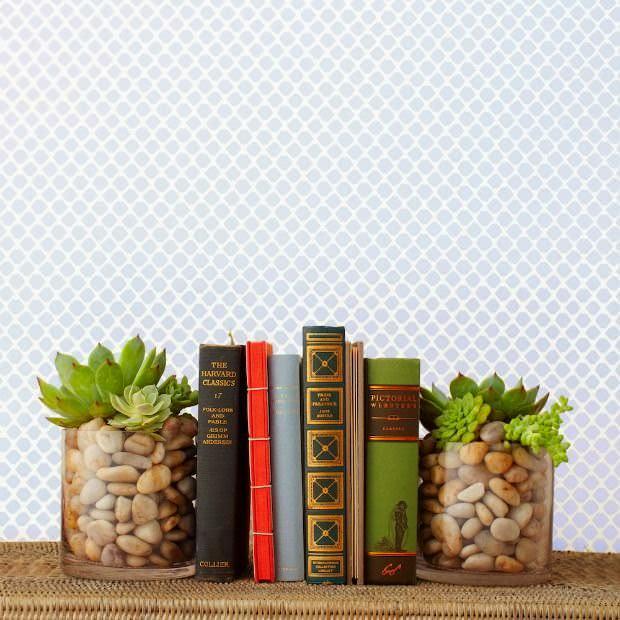
Prop up your favorite reads with this easy-to-make mini garden. Succulents are easy to grow. They add a welcome pop of greenery to any book collection when planted in clear vases filled with pretty river stones. See more of it here.
11. Hanging Coconut Planter
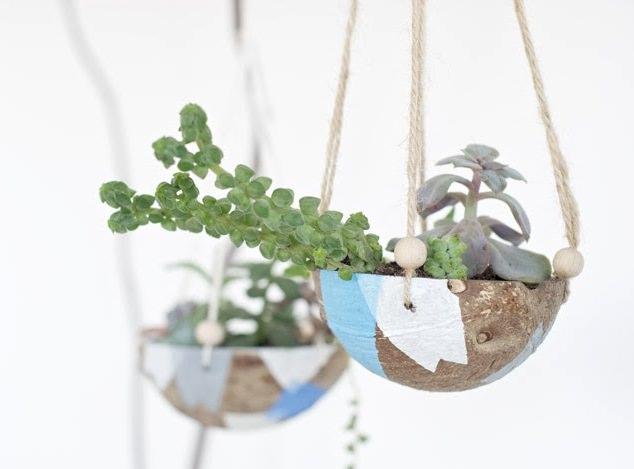
Use coconut shells after eating to create this super cute hanging indoor garden. This project is unique, still simple and doesn’t require much. Check out the tutorial here.
12. Sea Shell Planter
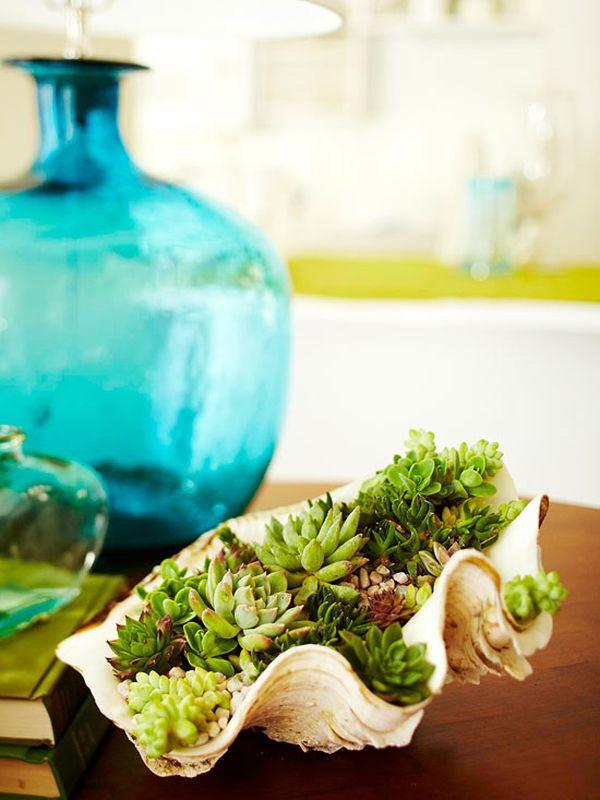
Sea-shell planters are creative ways to show off plants. You can tuck smaller succulents and use them as a centerpiece of your home. Check out these ideas!
13. Use Utility Cart to Hold Pots

Utility cart can be found in stores easily, it has many uses and one of them is this, especially if you’re short of space. Use it to hold planters.
14. Create an Indoor Fairy Garden

This well-planned fairy garden that resembles a gnome village (or many more other fairy garden ideas here) is looking amazing with colorful mushrooms, walkway, tiny houses, and banners.
15. Make a Succulent Dish Garden

Plant succulents in a dish and place it on the table top. It will make the focal point of the room. A complete DIY article on how to make a succulent dish garden is available here.
16. Plant Stand Room Dividers

Ikea plant stand (Socker series)
Plant stands can be used as room dividers, keeping cut beautiful cut flowers, herbs, and small plants. This way you’ll be able to maximize your growing space and create a division in a room too!
17. Keep a Plant Stand Near Window
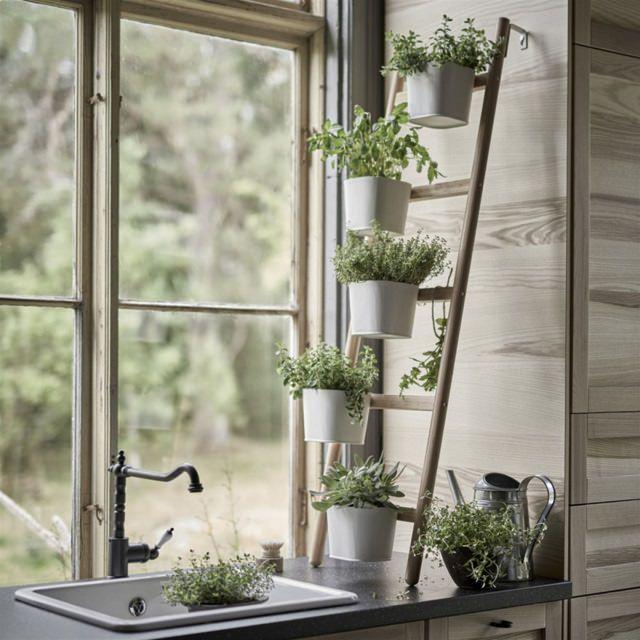
Why just keep plants on a windowsill, let the plants use the sunlight comes from the windows by keeping a plant stand like this.
18. Teacup Herb Garden

Grow a herb garden in vintage teacups that you no longer use. Not only it will look good but this way you will be able to grow your own herbs. If you want to make a teacup planter too, here is the tutorial.
Also Read: Indoor Herb Garden Ideas
19. DIY Mosaic Pots

Take some of your old clay pots and turn them into astonishing mosaic pots. It’s easy! You’ll need a terracotta pot, vase filler chips or alternatively use pot shard or broken tile pieces. You’ll also need glue and spray paint. The first step is to paint the pot in your favorite color and leave it to dry. Once done, lie the pot and glue the chips or shards one by one. See more mosaic ideas!
If you too love indoor gardening (like we do!), learn about the arrangement ideas, DIY tricks and how you can maximize your planting space available indoors in this article.
1. Use Wall Mounted Storage to Keep Pots

The space between windows can also be prime real estate for growing, just like this one in the picture above. You can use wall mounted storage to keep the pots to decorate your home with plants.
2. DIY Pegboard Planter

This DIY pegboard planter project is simple, inexpensive, and easy to follow. If you want to see the step by step tutorial, visit brePURPOSED!
3. DIY Ladder Planter/Ladder Shelf

If you have got an old ladder, use it to keep pots in it. It can be made into an astonishing pot holder, perfect for growing indoor plants. A step by step tutorial is available on our site!
4. DIY Succulent Frame or Succulent Wall Planter

A DIY succulent frame or succulent wall planter is a great way to add a whim to your interior without spending a lot of money on materials you can make this. Here is the tutorial to follow.
5. Mason Jar Ideas

Upcycle mason jars can used to grow herbs. Here are some DIY ideas.
Mason jar can become adorable small pots and can be used to grow plants and herbs indoors. There are myriads of ideas available on the web to look for inspiration, you can look at one of our posts for more ideas!
6. Indoor Chair Planter

Not only outdoors, if you’ve got an old chair create an indoor chair planter and grow succulents or indoor plants on it to add a dramatic touch to your rooms. See more chair planter ideas!
7. Indoor Zen or Japanese Garden

An indoor Japanese or Zen garden can be a beautiful addition to your home when combined with a water feature, flowers of cool colors, stones, or succulents, a great way to add “calmness” to your home. You can also make a mini succulent zen garden in a pot, check out the tutorial here.
8. Flowering Houseplants

Decorate your indoor garden with flowering houseplants. They can add a bright touch to your home, growing them is similar to other indoor plants. Check out our article on best flowering houseplants here.
9. Use Plant Stands

Plant stand can not only increase your indoor planting space but also look elegant and decorate your home. The best thing about them is that you can also DIY them easily, here are some ideas.
10. Succulent Bookend

Prop up your favorite reads with this easy-to-make mini garden. Succulents are easy to grow. They add a welcome pop of greenery to any book collection when planted in clear vases filled with pretty river stones. See more of it here.
11. Hanging Coconut Planter

Use coconut shells after eating to create this super cute hanging indoor garden. This project is unique, still simple and doesn’t require much. Check out the tutorial here.
12. Sea Shell Planter

Sea-shell planters are creative ways to show off plants. You can tuck smaller succulents and use them as a centerpiece of your home. Check out these ideas!
13. Use Utility Cart to Hold Pots

Utility cart can be found in stores easily, it has many uses and one of them is this, especially if you’re short of space. Use it to hold planters.
14. Create an Indoor Fairy Garden

This well-planned fairy garden that resembles a gnome village (or many more other fairy garden ideas here) is looking amazing with colorful mushrooms, walkway, tiny houses, and banners.
15. Make a Succulent Dish Garden

Plant succulents in a dish and place it on the table top. It will make the focal point of the room. A complete DIY article on how to make a succulent dish garden is available here.
16. Plant Stand Room Dividers

Ikea plant stand (Socker series)
Plant stands can be used as room dividers, keeping cut beautiful cut flowers, herbs, and small plants. This way you’ll be able to maximize your growing space and create a division in a room too!
17. Keep a Plant Stand Near Window

Why just keep plants on a windowsill, let the plants use the sunlight comes from the windows by keeping a plant stand like this.
18. Teacup Herb Garden

Grow a herb garden in vintage teacups that you no longer use. Not only it will look good but this way you will be able to grow your own herbs. If you want to make a teacup planter too, here is the tutorial.
Also Read: Indoor Herb Garden Ideas
19. DIY Mosaic Pots

Take some of your old clay pots and turn them into astonishing mosaic pots. It’s easy! You’ll need a terracotta pot, vase filler chips or alternatively use pot shard or broken tile pieces. You’ll also need glue and spray paint. The first step is to paint the pot in your favorite color and leave it to dry. Once done, lie the pot and glue the chips or shards one by one. See more mosaic ideas!
2
3
文章
扭扭
2017年05月23日

Indoor gardening can be a challenge if you’re short of space. And, for your help here’re the 15 Brilliant Vertical Indoor Garden Ideas, by applying a few of these you’ll be able to create more space!1. Vertical Pallet Planter
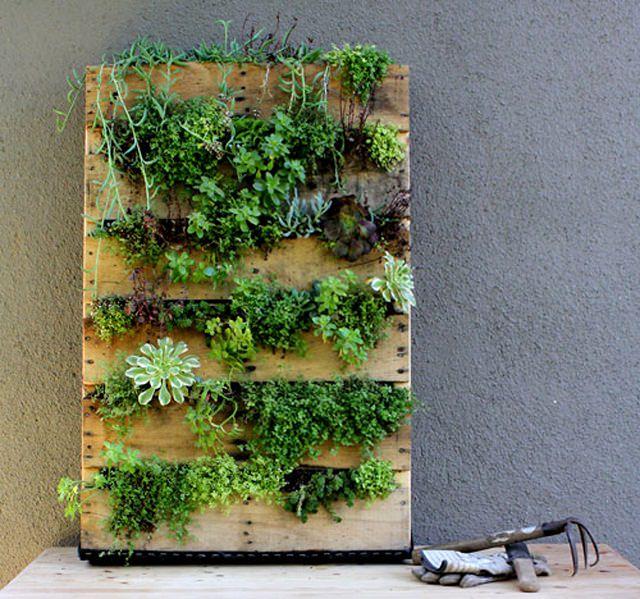
Make a vertical pallet planter to create an adorable indoor garden easily and inexpensively. They’ll provide enough space for growing herbs and succulents without taking a much of floor space. Check out how to make one.
2. Dresser Planter

A bit quirky idea! Use an old dresser to create a stunning indoor garden. Plant some ferns and succulents in its drawers and also place some on top to create a beautiful indoor garden.
3. Indoor Ladder Planter

Previously we wrote a lot about the use of ladder planter in a balcony or rooftop garden. A practical idea! You can apply it to your indoor garden too! An old ladder is perfect to grow multiple house plants in limited space. To make this, simply add several wood planks on ladder steps to create shelves. Then plants your houseplants on it but be sure to place houseplants that have similar light requirements. Here is more on it.
4. DIY Pot Hanger
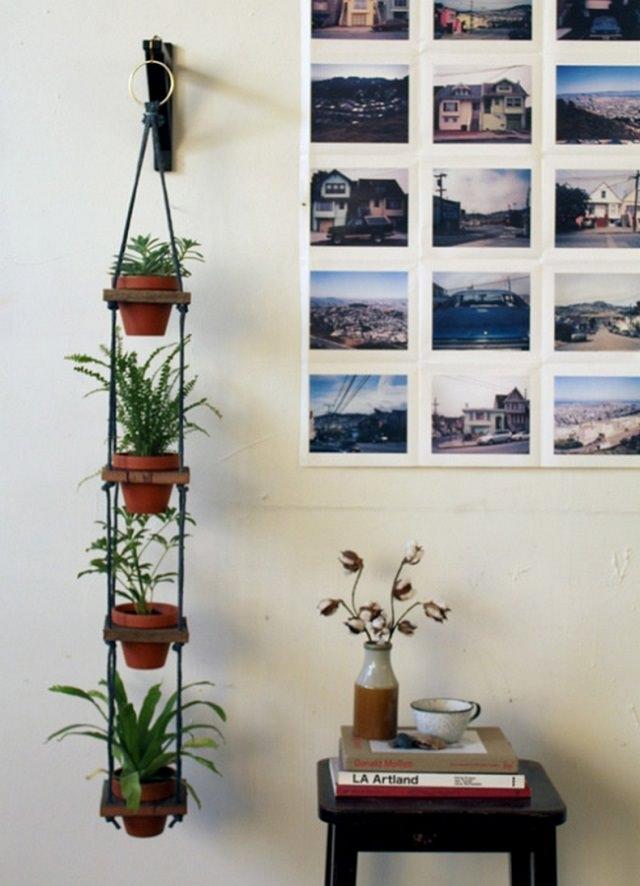
A unique (or say bizarre) way to display your favorite houseplants. This easy project only requires some scrap wood, rope, and a few basic woodworking tools. The best part is that the system makes watering a breeze. All the runoff from the previous pot drips into the plants below, so you only need to water the plant on top and be sure place a saucer under the bottom most pot. Here is the tutorial.
5. TV Stand Vertical Garden
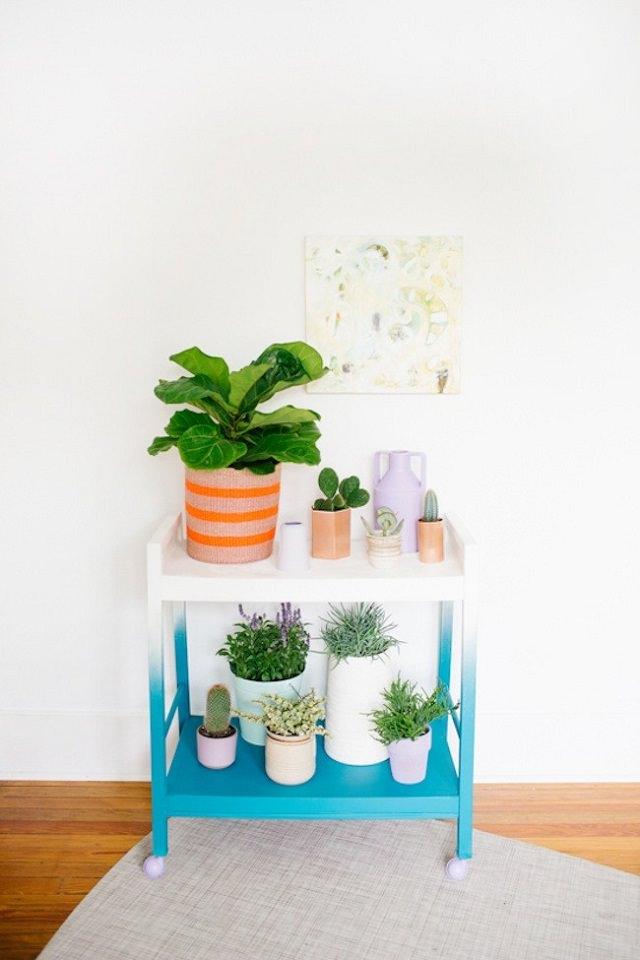
Got an old TV Stand? Make a vertical indoor garden out of it. This is a great way to recycle your old TV stand and transform it to a living beauty. You can either paint it for a fresh new look or use it as it is for a rustic look.
6. Hanging Plastic Bottle Cactus Garden
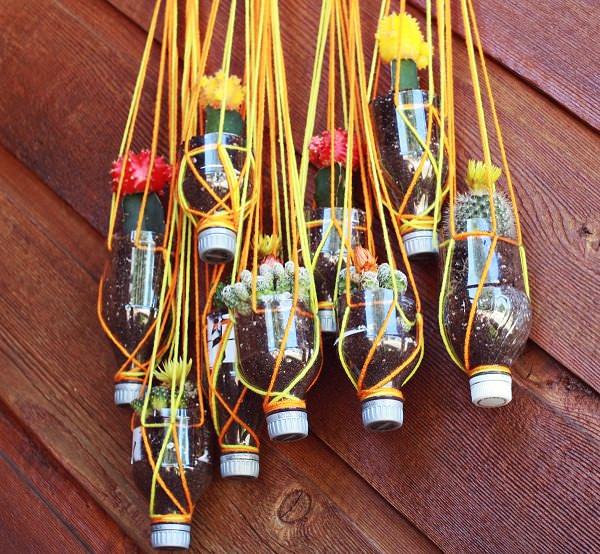
Do you want to create a vertical soda bottle garden? Follow this idea. All that is required is bottles cut in half, cactus plants or succulents, and many colorful threads to get a really cool decorative look. Here you can see the complete tutorial.
7. Shoe Organizer Vertical Garden
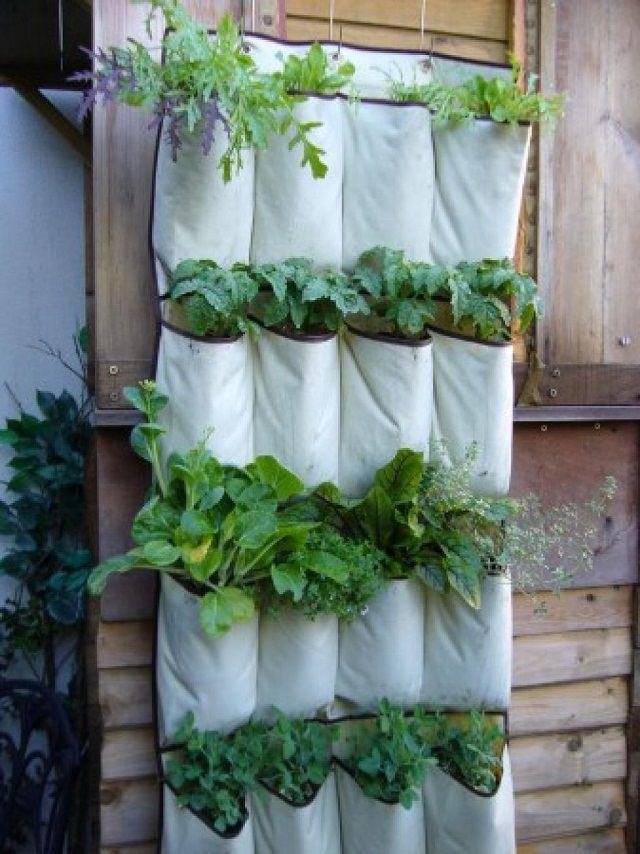
A hanging shoe organizer is perfect for your vertical INDOOR garden. Its pockets are the ideal size for growing individual plants and herbs. Get the DIY instructions here.
8. Vertical Herb Garden

Want to grow herbs but you don’t have space (short of budget too)? Well, even a wooden plank is enough. All you need is some plastic bottles, hooks, nails and hammer and you’re all set to grow your own herbs.
9. Mason Jar Vertical Garden

Don’t throw away those old mason jars, use them creatively to make an indoor herb wall garden. Metal bands and screws hold the jars in place against a scrap piece of wood that is mounted on the wall. Fill in the soil and plant your favorite herbs to use them all year round. Read about more Mason Jar Uses here!
10. Hanging Coconut Planter

Use coconut shells after eating to create this super cute hanging indoor garden. This project is unique, still simple and doesn’t require much. Check out the tutorial here.
11. Pallet Container Holder

Arrange a pallet board and hang several pots on it. It’s easy! And the best part is it will create plenty of vertical space.
12. Vertical Picture Frame Planter
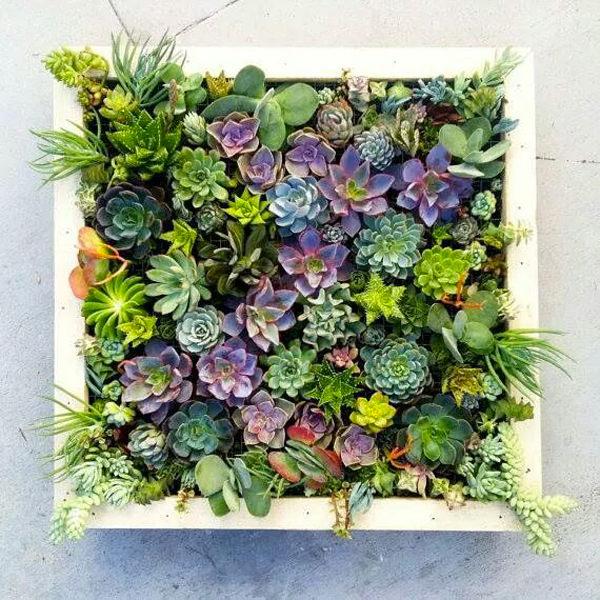
A cool idea for your room if it receives some sun to make it greener, you can hang a wall planter like this in your room. See the step by step tutorial on our website.
13. Vertical Pot Holder From Pallet Planks

Dismantle a pallet board and separate the pallet planks; nail them on to the wall and fix the pots. Simple!
14. Hanging Terracotta Planters

Vertical gardening is a boon for those who’re short of space. A tutorial is available here.
15. Iron Grid Pot Holder
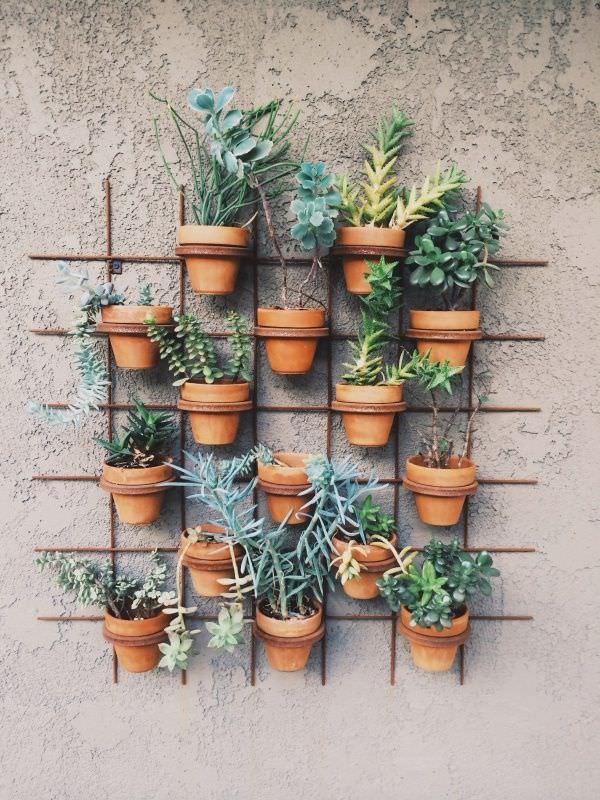
You can make a grid like this by welding the iron rods or weave them by any other method so that you’ll be able to hang the pots. You can paint that too in your favorite color. *The grid can also be made of wood.

Make a vertical pallet planter to create an adorable indoor garden easily and inexpensively. They’ll provide enough space for growing herbs and succulents without taking a much of floor space. Check out how to make one.
2. Dresser Planter

A bit quirky idea! Use an old dresser to create a stunning indoor garden. Plant some ferns and succulents in its drawers and also place some on top to create a beautiful indoor garden.
3. Indoor Ladder Planter

Previously we wrote a lot about the use of ladder planter in a balcony or rooftop garden. A practical idea! You can apply it to your indoor garden too! An old ladder is perfect to grow multiple house plants in limited space. To make this, simply add several wood planks on ladder steps to create shelves. Then plants your houseplants on it but be sure to place houseplants that have similar light requirements. Here is more on it.
4. DIY Pot Hanger

A unique (or say bizarre) way to display your favorite houseplants. This easy project only requires some scrap wood, rope, and a few basic woodworking tools. The best part is that the system makes watering a breeze. All the runoff from the previous pot drips into the plants below, so you only need to water the plant on top and be sure place a saucer under the bottom most pot. Here is the tutorial.
5. TV Stand Vertical Garden

Got an old TV Stand? Make a vertical indoor garden out of it. This is a great way to recycle your old TV stand and transform it to a living beauty. You can either paint it for a fresh new look or use it as it is for a rustic look.
6. Hanging Plastic Bottle Cactus Garden

Do you want to create a vertical soda bottle garden? Follow this idea. All that is required is bottles cut in half, cactus plants or succulents, and many colorful threads to get a really cool decorative look. Here you can see the complete tutorial.
7. Shoe Organizer Vertical Garden

A hanging shoe organizer is perfect for your vertical INDOOR garden. Its pockets are the ideal size for growing individual plants and herbs. Get the DIY instructions here.
8. Vertical Herb Garden

Want to grow herbs but you don’t have space (short of budget too)? Well, even a wooden plank is enough. All you need is some plastic bottles, hooks, nails and hammer and you’re all set to grow your own herbs.
9. Mason Jar Vertical Garden

Don’t throw away those old mason jars, use them creatively to make an indoor herb wall garden. Metal bands and screws hold the jars in place against a scrap piece of wood that is mounted on the wall. Fill in the soil and plant your favorite herbs to use them all year round. Read about more Mason Jar Uses here!
10. Hanging Coconut Planter

Use coconut shells after eating to create this super cute hanging indoor garden. This project is unique, still simple and doesn’t require much. Check out the tutorial here.
11. Pallet Container Holder

Arrange a pallet board and hang several pots on it. It’s easy! And the best part is it will create plenty of vertical space.
12. Vertical Picture Frame Planter

A cool idea for your room if it receives some sun to make it greener, you can hang a wall planter like this in your room. See the step by step tutorial on our website.
13. Vertical Pot Holder From Pallet Planks

Dismantle a pallet board and separate the pallet planks; nail them on to the wall and fix the pots. Simple!
14. Hanging Terracotta Planters

Vertical gardening is a boon for those who’re short of space. A tutorial is available here.
15. Iron Grid Pot Holder

You can make a grid like this by welding the iron rods or weave them by any other method so that you’ll be able to hang the pots. You can paint that too in your favorite color. *The grid can also be made of wood.
1
0
文章
Colorful
2017年05月23日

Love growing plants indoors? Some of the best indoor vines and climbers that are easy to grow are listed here. Must check out!A house with indoor plants looks more lavish and expensive. That’s a fact!1. Heartleaf Philodendron
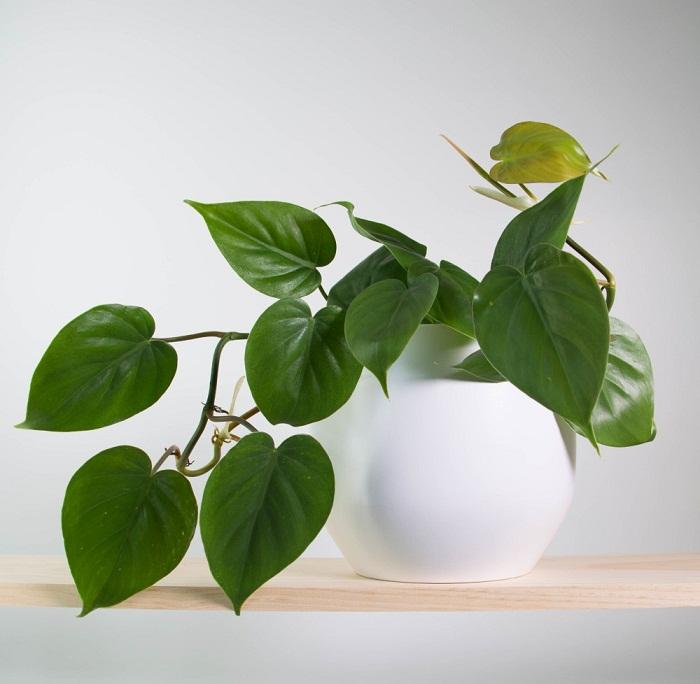
Heartleaf Philodendron is extremely easy to grow and great for beginners. It needs a moderate amount of light and prefers the soil to dry out between watering spells.
Also Read: Easiest Indoor Plants
2. Ivy
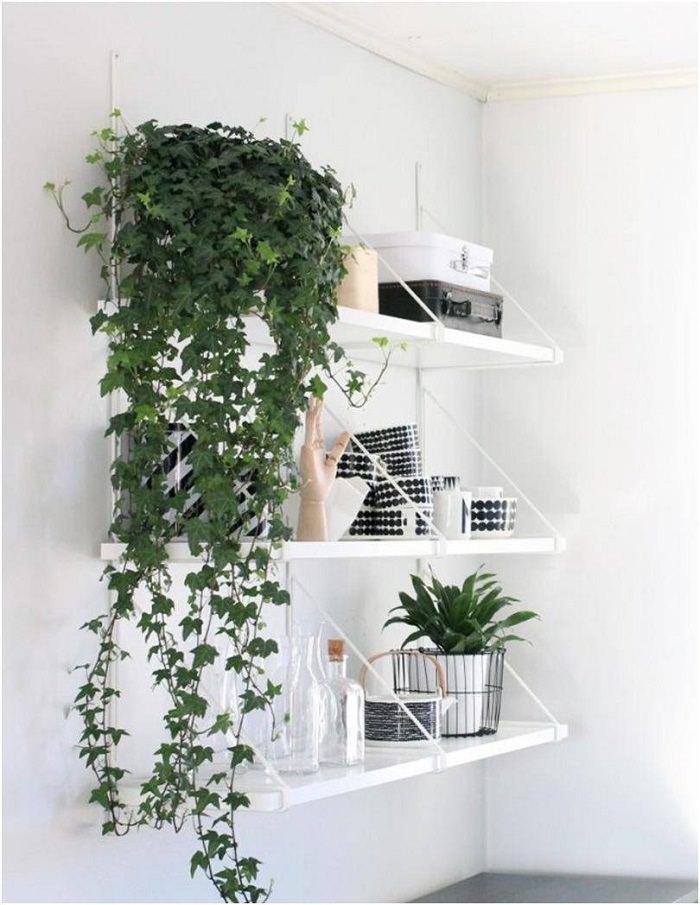
Ivy is one of the best indoor vines. It can easily adapt to many light conditions. This fast-growing vine has evergreen foliage that remains green even in winters. Plant it in a container that is wide and shallow rather than narrow and deep. Keep the pot in a spot that receives bright indirect sun.
Also Read: Best Indoor Plants According to Different Light Conditions
3. Pothos
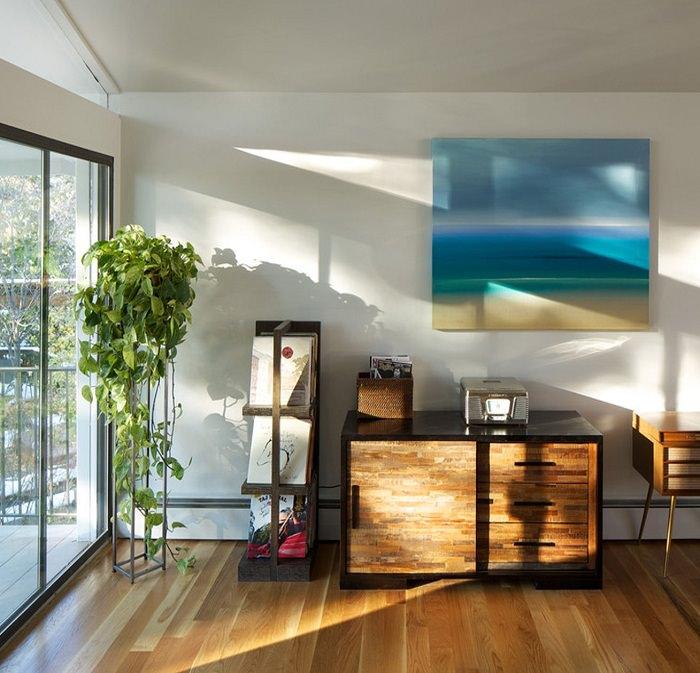
Plants of the pothos family are easiest to grow and most of them can even grow without direct sunlight. They become great houseplants for beginners. Attractive and hardy vine prefers bright indirect light and a draft free place. It can grow in low light and needs moist soil.
Also Read: Plants You can Grow Without Sunlight
4. Betel Leaf Plant
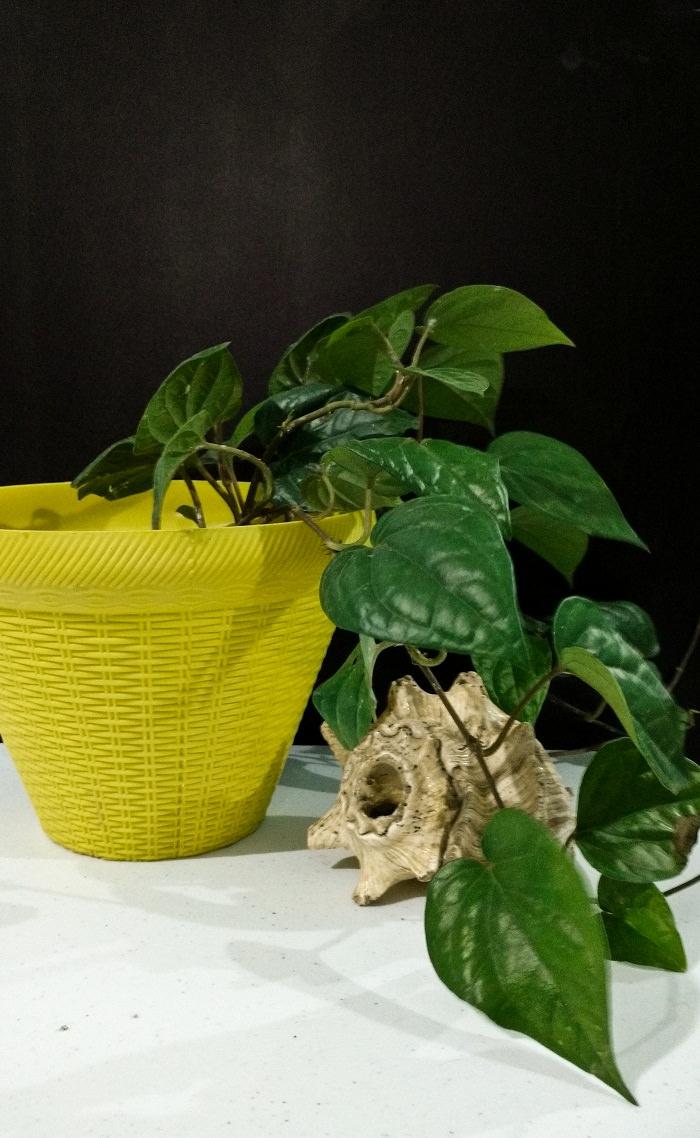
Betel leaf plant is very popular in South and East Asia, especially in the Indian subcontinent, Indonesia, Vietnam, and Thailand. This vine from pepper family has many culinary and medicinal uses. It can be tried indoors if space where you want to keep it receives part sun and remains slightly humid. All the other information is available here.
5. Jasmine

Many jasmine varieties can be grown indoors. If you keep this most fragrant vine in a bright spot where it receives some hours of direct sunlight daily, it’ll grow. The selection of jasmine varieties you want to plant indoors depends on the climate you live in. For colder regions, Jasminum polyanthum is the one you can try, whereas in tropics most of the plants from this species will grow.
6. Creeping Fig

It’s a slow growing creeper with small, leathery dark green foliage. Vigorous-growing, clinging, dense branches adhere to any surface and look enchanting. Be careful not to overwater creeping fig. Let the soil dry out before watering.
7. Arrowhead Plant

This elegant vine like houseplant prefers to be in a spot that is bright, needs moderate watering. Allow the soil to dry out between watering spells and make sure not to overwater it, as it may lead to root rot.
Also Read: Houseplants that are Harmful to Dogs
8. Hoya (Hoya spp.)

Beautiful waxy foliage and fragrant flowers, hoya looks stunning when grown indoors. The plant has low watering needs and doesn’t mind if you forget to water it occasionally. The trailing stems of this plant is approximately a foot in length along with clusters of aromatic waxy flowers.
Also Read: 99 Great Ideas to Display Houseplants
9. String Of Pearls
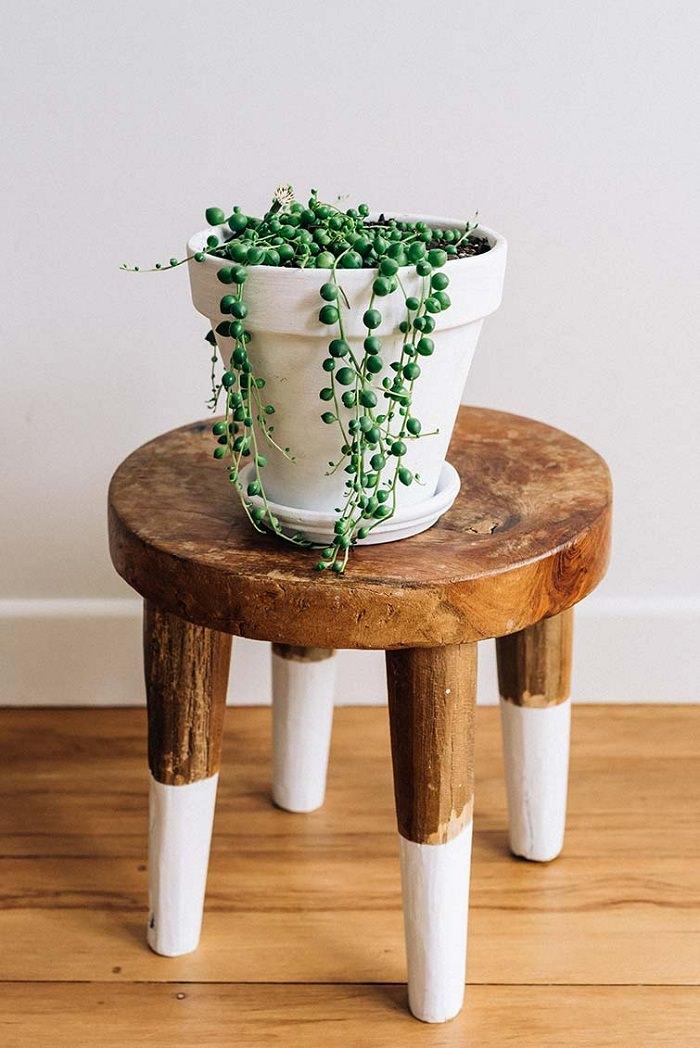
Growing string of pearls is easy, it is a low-maintenance creeper. This succulent tolerates prolonged drought and does well in a bright light position. You can also combine it with other houseplants to create a great appearance or it can be grown in a hanging basket.
10. Black Eyed Susan Vine

Black-eyed Susan vine can be grown indoors. Depending on your climate, this annual or perennial flowering plant can add a dramatic appeal to your rooms. Keep it near a window, where it receives a lot of sun.
11. Inch Plant
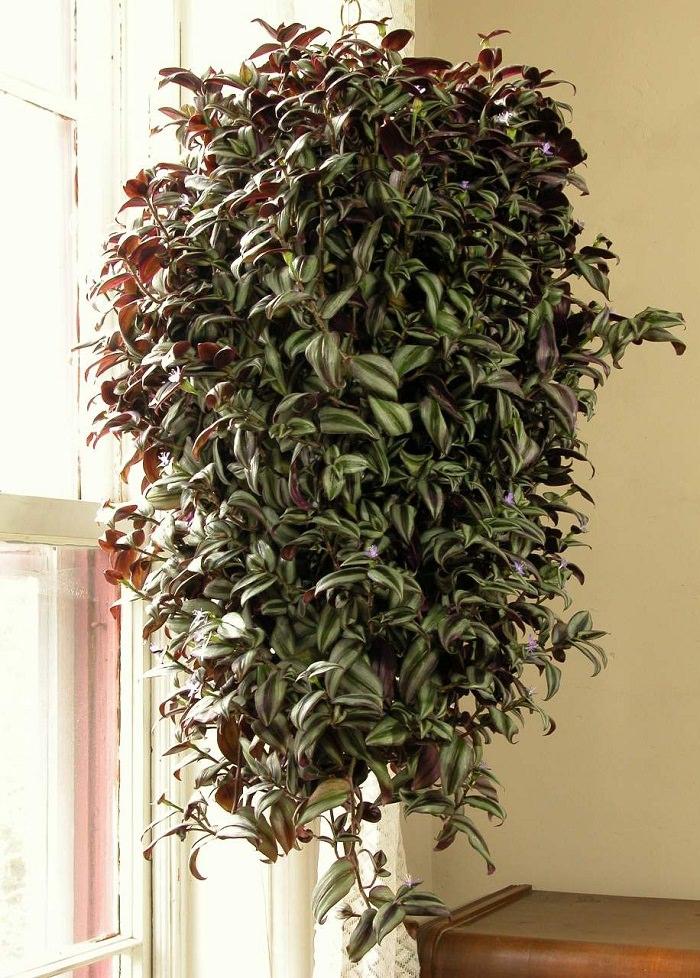
Also called “Wandering Jew” or “Purple heart”, this wonderful houseplant has beautiful trailing stems with attractive zebra patterned foliage that look stunning. Grow it in a pot or hanging basket, it’ll thrive. You can also keep this plant in dim light, but the markings on the foliage will fade.

Heartleaf Philodendron is extremely easy to grow and great for beginners. It needs a moderate amount of light and prefers the soil to dry out between watering spells.
Also Read: Easiest Indoor Plants
2. Ivy

Ivy is one of the best indoor vines. It can easily adapt to many light conditions. This fast-growing vine has evergreen foliage that remains green even in winters. Plant it in a container that is wide and shallow rather than narrow and deep. Keep the pot in a spot that receives bright indirect sun.
Also Read: Best Indoor Plants According to Different Light Conditions
3. Pothos

Plants of the pothos family are easiest to grow and most of them can even grow without direct sunlight. They become great houseplants for beginners. Attractive and hardy vine prefers bright indirect light and a draft free place. It can grow in low light and needs moist soil.
Also Read: Plants You can Grow Without Sunlight
4. Betel Leaf Plant

Betel leaf plant is very popular in South and East Asia, especially in the Indian subcontinent, Indonesia, Vietnam, and Thailand. This vine from pepper family has many culinary and medicinal uses. It can be tried indoors if space where you want to keep it receives part sun and remains slightly humid. All the other information is available here.
5. Jasmine

Many jasmine varieties can be grown indoors. If you keep this most fragrant vine in a bright spot where it receives some hours of direct sunlight daily, it’ll grow. The selection of jasmine varieties you want to plant indoors depends on the climate you live in. For colder regions, Jasminum polyanthum is the one you can try, whereas in tropics most of the plants from this species will grow.
6. Creeping Fig

It’s a slow growing creeper with small, leathery dark green foliage. Vigorous-growing, clinging, dense branches adhere to any surface and look enchanting. Be careful not to overwater creeping fig. Let the soil dry out before watering.
7. Arrowhead Plant

This elegant vine like houseplant prefers to be in a spot that is bright, needs moderate watering. Allow the soil to dry out between watering spells and make sure not to overwater it, as it may lead to root rot.
Also Read: Houseplants that are Harmful to Dogs
8. Hoya (Hoya spp.)

Beautiful waxy foliage and fragrant flowers, hoya looks stunning when grown indoors. The plant has low watering needs and doesn’t mind if you forget to water it occasionally. The trailing stems of this plant is approximately a foot in length along with clusters of aromatic waxy flowers.
Also Read: 99 Great Ideas to Display Houseplants
9. String Of Pearls

Growing string of pearls is easy, it is a low-maintenance creeper. This succulent tolerates prolonged drought and does well in a bright light position. You can also combine it with other houseplants to create a great appearance or it can be grown in a hanging basket.
10. Black Eyed Susan Vine

Black-eyed Susan vine can be grown indoors. Depending on your climate, this annual or perennial flowering plant can add a dramatic appeal to your rooms. Keep it near a window, where it receives a lot of sun.
11. Inch Plant

Also called “Wandering Jew” or “Purple heart”, this wonderful houseplant has beautiful trailing stems with attractive zebra patterned foliage that look stunning. Grow it in a pot or hanging basket, it’ll thrive. You can also keep this plant in dim light, but the markings on the foliage will fade.
4
4
文章
安静的美女子
2017年05月23日

Check out this list of best flowering houseplants! They can add a bright touch to your home, growing them is similar to other indoor plants.1. Begonia

Although begonias are considered as outdoor plants, there are many plants from begonia genus that makes great flowering houseplants. Most of them are easy to grow and good for beginners. Wax Begonia, Rieger Begonia, and Angel-Wing Begonia are among the best and most popular houseplants.
2. Bromeliads

Its colorful foliage and long lasting flowers can beautify any interior. It thrives easily without much care and the best thing is that you can grow this houseplant in low light conditions too.
3. African violet

African violets are easy to grow flowering plants that can be grown indoors for their beautiful flowers and foliage, they prefer warm climate rather than cold. Keep these plant in a spot where they receive filtered sun.
4. Scented Geranium

Scented geraniums with fragrant leaves and bright colorful flowers become incredible houseplants. However, growing geranium indoors is not as easy as other flowering houseplants we have here in this list. It requires a south or west facing window that receives ample sun and moderate watering.
5. Poinsettia

Growing poinsettias in your home can add a bright touch to your interior. Its multicolor bracts look more colorful than its flowers. This tropical plant requires, light, warmth and protection from drafts to thrive indoors.
6. Peace Lily

If you want to grow a low-care plant, grow peace lily. Inside your home, it can live without water for days. Peace lily’s beautiful white flowers flourish in low lighting conditions. It also removes the toxins from the air.
7. Lipstick Plant

Although not commonly grown as a houseplant, lipstick plant can be grown indoors. It requires constantly warm temperature and humid surrounding to grow and thrive. Here is more on how to grow lipstick plant.
8. Jasmine

Many jasmine varieties can be grown indoors. If you keep this most fragrant vine in a bright spot where it receives some hours of direct sunlight daily, it’ll grow. The selection of jasmine varieties you want to plant indoors depends on the climate you live in. For colder regions, Jasminum polyanthum is the one you can try, whereas in tropics most of the plants from this species will grow.
9. Impatiens
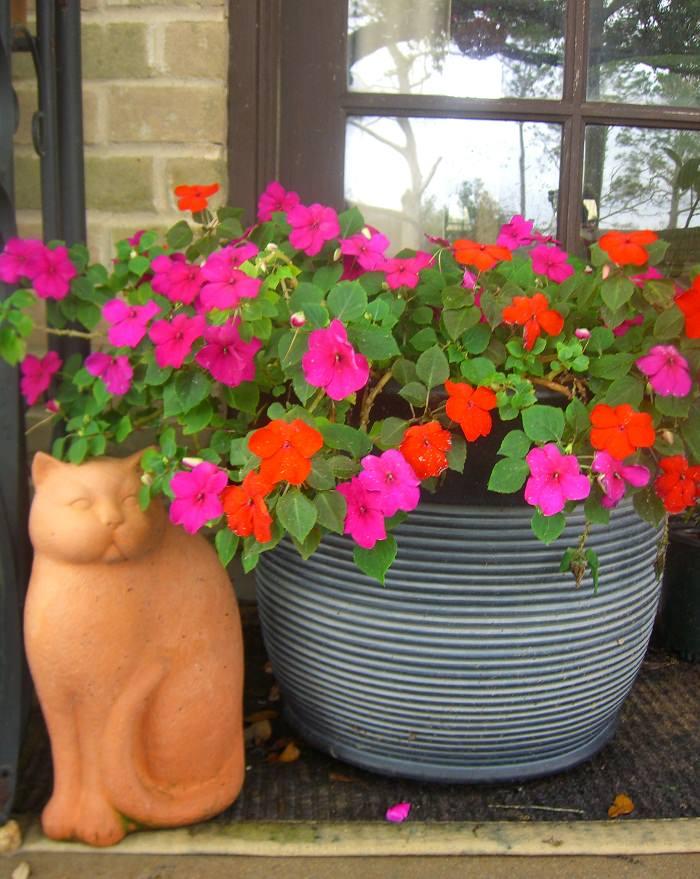
Impatiens are beautiful shade loving annuals but in optimum conditions, you can grow them year-round as a houseplant. Maintain room temperature above 50-55 F and place the pot in a spot that receives bright indirect sun all day long, it would be better if you can provide 1-2 hours of direct sunlight too.
10. Kalanchoe

Kalanchoe is a tropical succulent, plants of this genus grows best outdoors in warm climates. However, it can be grown indoors. This flowering succulent comes in a variety of colors and has low watering needs. You can keep it near a window where it can receive a few hours of sun in order to bloom.
11. Oxalis or Purple Leaf Shamrock

This beautiful flowering houseplant can adorn your house with showy purple foliage and white or pink flowers. Place it at a bright spot for abundant blooms and allow the soil to dry out between watering spells.
12. Cape Primrose

Cape Primrose or “Streptocarpus x hybridus” is a relative of the African violet. If you keep the soil lightly moist and give it bright, indirect sun year-round, it will bloom continuously. Also, there are many new hybrid varieties available with bigger flowers, longer blooming time, and more compact foliage.
13. Christmas Cactus

Christmas cactus is an old-fashioned favorite houseplant of many. When it blooms it creates a warm atmosphere. Red, pink, white or orange: The lovely flowers can quickly brighten up any interior. If maintained well, it can even bloom again from one year to another for years.
Also Read: How to Make Christmas Cactus Bloom at Christmas
14. Crown of Thorns

The Crown of Thorns becomes an exceptional houseplant due to its continuous blooms and low watering needs. If you can provide a sunny window where the plant can be placed, it will grow happily. Available in so many colors, the plant prefers loamy succulent soil and warm temperature.
15. Black Eyed Susan Vine

Black-eyed Susan vine can be grown indoors. Depending on your climate, this annual or perennial flowering plant can add a dramatic appeal to your rooms. Keep it near a window, where it receives a lot of sun.
Also Read: Best Indoor Vines
16. Purple Heart or Inch Plant (Wandering Jew)

A cluster of purple, lance-shaped leaves makes purple heart an impressive houseplant with or without its pink flowers. This beautiful trailing indoor plant can be grown in small colorful pots or hanging baskets and can be used as a table accent. Keep your purple heart (Tradescantia pallida) plant in a spot where it will receive 2-3 hours of sun for a healthy plant.
Note: Several other plants from this genus apart from Tradescantia pallida are known with similar names! For example, Tradescantia zebrina and Tradescantia fluminensis17. Orchids

Orchids are different from other houseplants. Unlike ferns, philodendrons, palms and Swedish ivy, orchids do not grow in soil. Putting an orchid in soil is actually one of the best ways to kill it. You can learn more about growing orchid indoors here.

Although begonias are considered as outdoor plants, there are many plants from begonia genus that makes great flowering houseplants. Most of them are easy to grow and good for beginners. Wax Begonia, Rieger Begonia, and Angel-Wing Begonia are among the best and most popular houseplants.
2. Bromeliads

Its colorful foliage and long lasting flowers can beautify any interior. It thrives easily without much care and the best thing is that you can grow this houseplant in low light conditions too.
3. African violet

African violets are easy to grow flowering plants that can be grown indoors for their beautiful flowers and foliage, they prefer warm climate rather than cold. Keep these plant in a spot where they receive filtered sun.
4. Scented Geranium

Scented geraniums with fragrant leaves and bright colorful flowers become incredible houseplants. However, growing geranium indoors is not as easy as other flowering houseplants we have here in this list. It requires a south or west facing window that receives ample sun and moderate watering.
5. Poinsettia

Growing poinsettias in your home can add a bright touch to your interior. Its multicolor bracts look more colorful than its flowers. This tropical plant requires, light, warmth and protection from drafts to thrive indoors.
6. Peace Lily

If you want to grow a low-care plant, grow peace lily. Inside your home, it can live without water for days. Peace lily’s beautiful white flowers flourish in low lighting conditions. It also removes the toxins from the air.
7. Lipstick Plant

Although not commonly grown as a houseplant, lipstick plant can be grown indoors. It requires constantly warm temperature and humid surrounding to grow and thrive. Here is more on how to grow lipstick plant.
8. Jasmine

Many jasmine varieties can be grown indoors. If you keep this most fragrant vine in a bright spot where it receives some hours of direct sunlight daily, it’ll grow. The selection of jasmine varieties you want to plant indoors depends on the climate you live in. For colder regions, Jasminum polyanthum is the one you can try, whereas in tropics most of the plants from this species will grow.
9. Impatiens

Impatiens are beautiful shade loving annuals but in optimum conditions, you can grow them year-round as a houseplant. Maintain room temperature above 50-55 F and place the pot in a spot that receives bright indirect sun all day long, it would be better if you can provide 1-2 hours of direct sunlight too.
10. Kalanchoe

Kalanchoe is a tropical succulent, plants of this genus grows best outdoors in warm climates. However, it can be grown indoors. This flowering succulent comes in a variety of colors and has low watering needs. You can keep it near a window where it can receive a few hours of sun in order to bloom.
11. Oxalis or Purple Leaf Shamrock

This beautiful flowering houseplant can adorn your house with showy purple foliage and white or pink flowers. Place it at a bright spot for abundant blooms and allow the soil to dry out between watering spells.
12. Cape Primrose

Cape Primrose or “Streptocarpus x hybridus” is a relative of the African violet. If you keep the soil lightly moist and give it bright, indirect sun year-round, it will bloom continuously. Also, there are many new hybrid varieties available with bigger flowers, longer blooming time, and more compact foliage.
13. Christmas Cactus

Christmas cactus is an old-fashioned favorite houseplant of many. When it blooms it creates a warm atmosphere. Red, pink, white or orange: The lovely flowers can quickly brighten up any interior. If maintained well, it can even bloom again from one year to another for years.
Also Read: How to Make Christmas Cactus Bloom at Christmas
14. Crown of Thorns

The Crown of Thorns becomes an exceptional houseplant due to its continuous blooms and low watering needs. If you can provide a sunny window where the plant can be placed, it will grow happily. Available in so many colors, the plant prefers loamy succulent soil and warm temperature.
15. Black Eyed Susan Vine

Black-eyed Susan vine can be grown indoors. Depending on your climate, this annual or perennial flowering plant can add a dramatic appeal to your rooms. Keep it near a window, where it receives a lot of sun.
Also Read: Best Indoor Vines
16. Purple Heart or Inch Plant (Wandering Jew)

A cluster of purple, lance-shaped leaves makes purple heart an impressive houseplant with or without its pink flowers. This beautiful trailing indoor plant can be grown in small colorful pots or hanging baskets and can be used as a table accent. Keep your purple heart (Tradescantia pallida) plant in a spot where it will receive 2-3 hours of sun for a healthy plant.
Note: Several other plants from this genus apart from Tradescantia pallida are known with similar names! For example, Tradescantia zebrina and Tradescantia fluminensis17. Orchids

Orchids are different from other houseplants. Unlike ferns, philodendrons, palms and Swedish ivy, orchids do not grow in soil. Putting an orchid in soil is actually one of the best ways to kill it. You can learn more about growing orchid indoors here.
1
2
文章
Gina
2017年05月23日
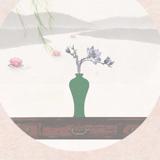

Houseplants are just another way to garden. Indoor gardening has been polar for centuries, and I think it’s a basic human need to want to nurture nature, even within our homes. Plus, houseplants are great decorating accents, and help clean the air within a home. However, I think killing houseplants is an all time top factor behind the term “black thumb”. There are houseplants, however, that are easy to grow, and hard to kill. Here are our top easy houseplants that any gardener can grow indoors. In addition, the plants we have chosen are great for families because they are all non-poisonous. Remember however, to always check with your poison control center with the Latin name from the tag on the plant you buy. Our featured photo plant (above) is the house plant Peperomia. Easy to find in any nursery, and tolerant of a wide range of conditions. Prefer well drained soil, bright light and only water when soil is dry on the surface.
Norfolk Pine – This is an upright plant that reminds me of Christmas. In fact, my Norfolk Pine started it’s life as a mini holiday tree during December vacation to the beaches of Oregon. Likes bright light, but not direct sun. Can grow up to ten feet tall with time. Loves moist air as well, so keep out of the draft of a heating vent. Water when soil surface is dry to the touch.
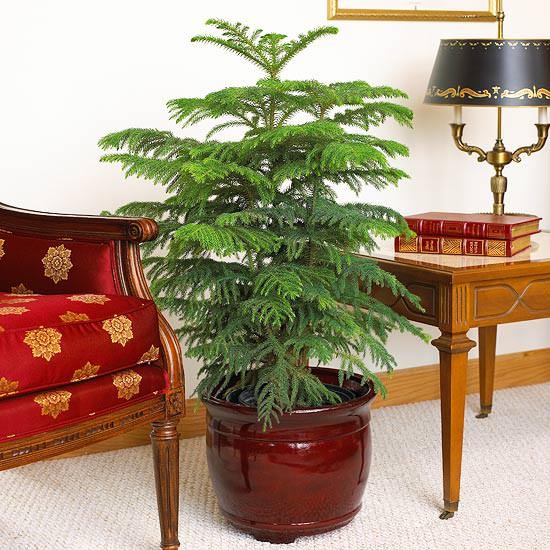
Spider Plant – Who doesn’t love a Spider Plant? Famous for their “babies”, or little plant lets that grow at the ends of stems, and their wonderful arching shape. You can root the “babies” in water easily and create more plants! I love the variegated foliage. Bright to medium light. Keep evenly moist. Leaves will lose color if they are thirsty, but they will bounce right back.
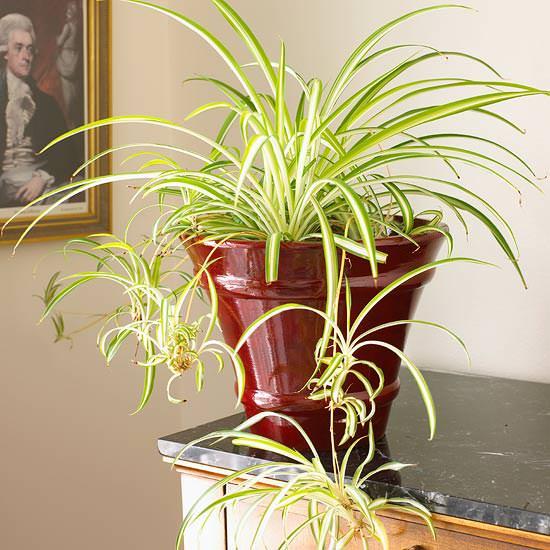
Umbrella Tree (Shefflera) – This larger upright plant has a fan of glossy dark green leaves attached to each stem. Can grow to eight feet tall. Will look leggy in too low of light. Water moderately.

Grape Ivy – Do not confuse this with English Ivy, which can be poisonous. Grape ivy is a wonderful hanging plant, and has glossy bright green leaves shaped like an oak leaf. Will tolerate lower light, but prefers moderate light. Water moderately.
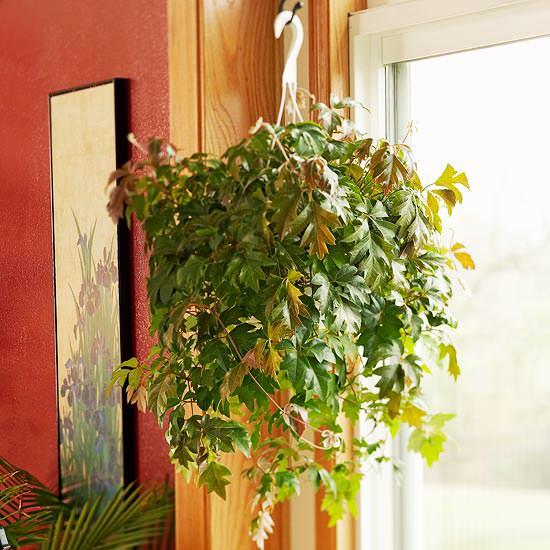
Cast Iron Plant – This plant coms by it’s name honestly…its made like cast iron! Hard to kill… will even bounce back from a bad wilt from lack of water, will tolerate low light and neglect. That having been said, it’s stripy leaves (sometimes spotted with cream) look best in medium light, with evenly moist soil. Thats it! Doesn’t get easier!
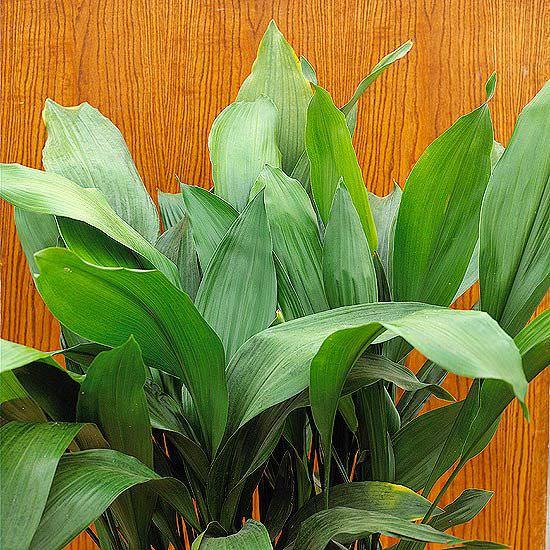
Whether it’s because it’s the depths of winter and you want to see some green living things, or just because you enjoy having houseplants in your home, these easy houseplants are a great place for busy gardeners to start their “indoor garden”.
0
0
成长记
riverrun
2017年05月01日
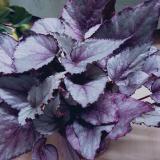
Saint is done. Two rainy weeks and he didnt get the sun he needed. This is not a European Climate Plant, I dont recommend it to anyone here. Its also not a indoor plant when you dont have greenhouse conditions inside, which I hope you dont, cause that would not be comfortable to live in. Anyway bye Saint thanks for being so pretty for such a long time 😢
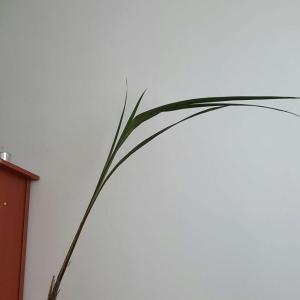

0
0
fyfywong:Oh, poor Saint...🙁You've done your best taking care of him. No regrets.
文章
Gina
2017年03月16日


Spring is just around the corner, and indoor seed starting is even closer… Many of us are looking for ways to mark out flats, pots and rows without using those ugly plastic sticks… The garden should not be treated just as a utilitarian space! Here are some easy DIY plant marker projects that will get you excited about popping those first seedlings into newly warmed earth…and actually remembering what you planted there! Our featured project from Our Little Coop (above) uses chalkboard paint to make garden marker signs… easy tutorial!
Our first project inspiration comes from The Micro Gardner, and we love this idea! How cool is this? Terra Cotta Plant Markers – Sharpie and broken terra cotta pots…

Scissors and Spatulas has a great tutorial on using chalkboard paint and pots… and you know we’ve been into the chalkboard paint lately! This is great because when you change plants in each pot, you just erase and write the new name!

42 Things on Etsy has these garden plant markers that are natural, clever and cool…
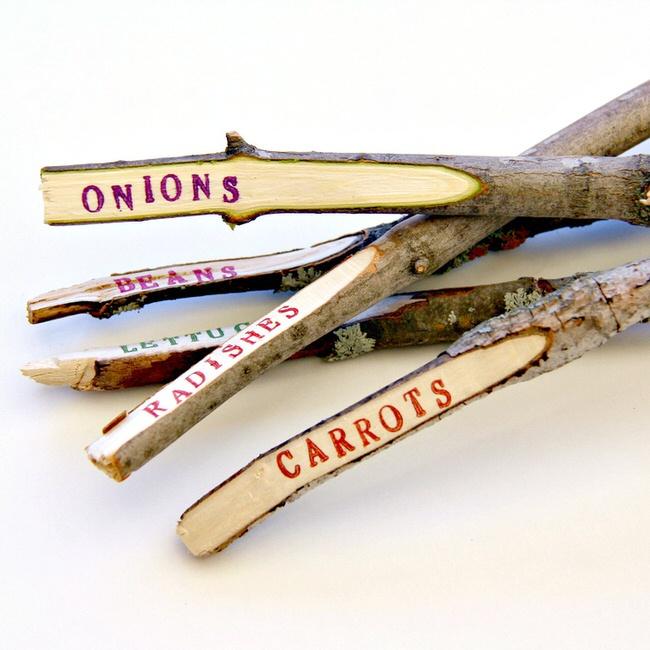
Or create similar plant markers yourself…

Learn how to make these charming wooden spoon plant markers from DIY Adventures.

Create these brick style garden markers with a thick sharpie or paint. Great for marking rows, you don’t have to worry about losing your markers in the wind and forgetting which row is which!

Aunt Peaches created these aluminum tape garden markers for less than $5 for 50!

Finally, these DIY wine cork garden markers by Happier Homemaker are perfect for me! I knew I save all those wine corks for a reason!

So get some seeds planted, but first pick one of these great DIY plant markers projects and get crafting for the garden!
1
1
文章
Gina
2017年03月16日


If you are looking for an indoor gardening project that is cool, easy and just a little bit trendy, cactus and succulent projects are for you! Here we found for you some great inspiration and tutorials to help you bring the modern vibe to any room of your home. Did we mention, they are really easy to take care of, too? So if your thumb is brown, that’s ok… these plants and projects are just for you! Our featured project above and below, is from Cassidy at ‘Succulents and Sunshine’. Oh my, these are cute! These DIY painted planters are perfect little accents, and the succulents are really easy to grow. While you are there checking out her tutorial, be sure to check out her e-book, “How to Grow Succulents Indoors“. Then you will be an expert too!
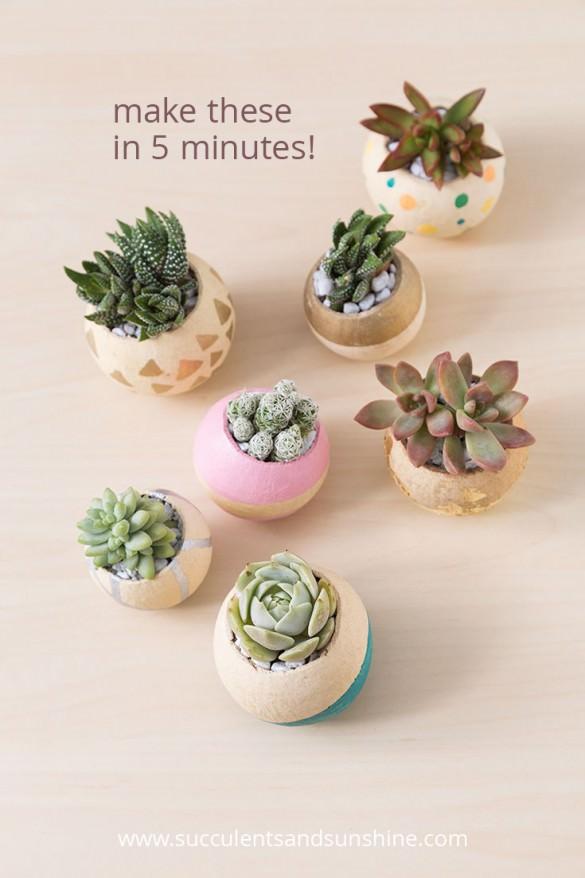
From Brittni Mehlhoff via ‘Curbly’, these DIY metallic planters took her 5 minutes to make. Cactus and succulents always look better when displayed in a cool pot… Simple, fast, easy!

Want to do a project that is a bit more traditional? Learn how to make an indoor succulent dish garden from Manuela at ‘A Cultivated Nest’. Pretty way to use those dishes that aren’t very practical, but too gorgeous to get rid of!

Again from Cassidy at ‘Succulents and Sunshine’, these miniature succulent bird cages look like so much fun to put together, and can be whimsical or traditional… Ok, and they are just so sweet! Find out just how to make them.
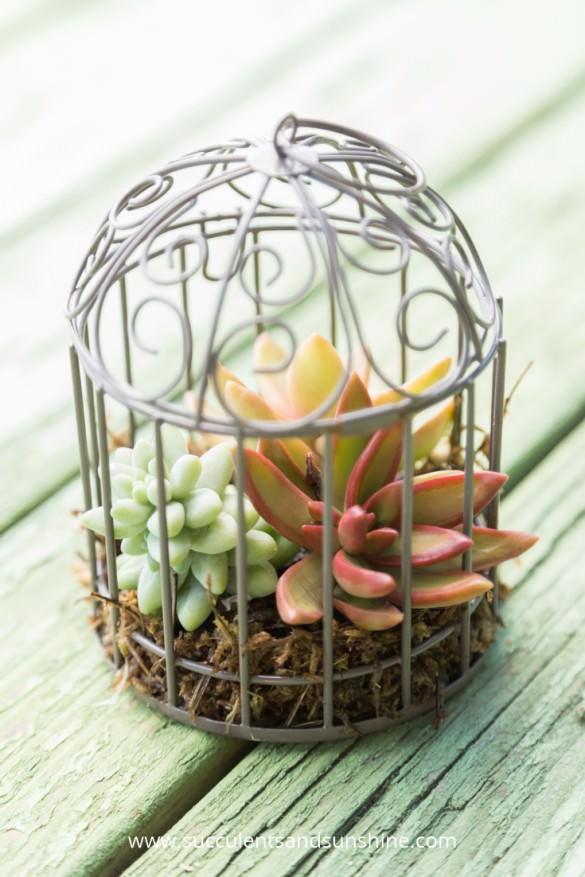
Looking for a simple cacti garden? Elsie at ‘A Beautiful Mess’ has you covered, and teaches you all about getting it done. Pretty colors on these desert plants!

Need a little “Zen”? Put down those adult coloring books, and try out this bright and cheerful Zen garden from Allison at ‘Dream a Little Bigger’. Step by step photos, and you gotta love that color! Perfect for your desk, right? That’s what I was thinking’…

Don’t want to figure it all out yourself? We found this Zen terrarium kit at the Etsy shop ‘Wendiland’… When we checked, this wasn’t available, but others like it were!

From ‘East Coast Creative’ learn how to make a DIY garden wall, from start to end! Great tutorial with step by step photos… depending on how large you make yours, this could be a major focal piece in a room. Love!

Make this DIY wire plant stand with this tutorial from ‘The Merry Thought’ to make your cacti stand out above the rest. Want to guess what she used?

I love these DIY mid century plant stands by ‘Sugar and Cloth’… they are perfect for the vibe of any cactus, don’t you think? These Christmas cacti will look amazing when they bloom! Yes, cacti bloom!

That isn’t enough? You need more ideas? Try this planted vintage dump truck from ‘The Potted Store’…

And if that wasn’t enough, jump on over to our post on sedum and succulent planters, for outdoors!
3
0
文章
Abigal
2017年03月15日


The garden is an extension of your home, so there is no reason you can’t give just as much attention to your outdoor rooms as you do your indoor ones! Just remember to look at your outdoor room in the same way…floor, walls, ceiling, furniture and accessories. Your accessories might just be flowers and plants is all! Along the way, use these DIY outdoor room ideas and tutorials to style a fresh space outdoors!
In our feature photo, above, HGTV uses a standard chaise lounge to create a daybed on their outdoor room, by laying it flat and pushing it against the deck railing as backdrop. Add pillows, and maybe a cozy throw, and what a wonderful place to nap away a summer afternoon!
Create a painted outdoor rug with a can of spray paint, some stencils or hand painting, and a clear sealant.

Lighting in your outdoor room makes a paradise on warm summer evenings… Hanging lights can be inexpensive and can make or break a room used after sunset.

This DIY twinkle light porch canopy from Opaque Canvas was made for less than $25, and they have a full tutorial. This would look amazing at night!
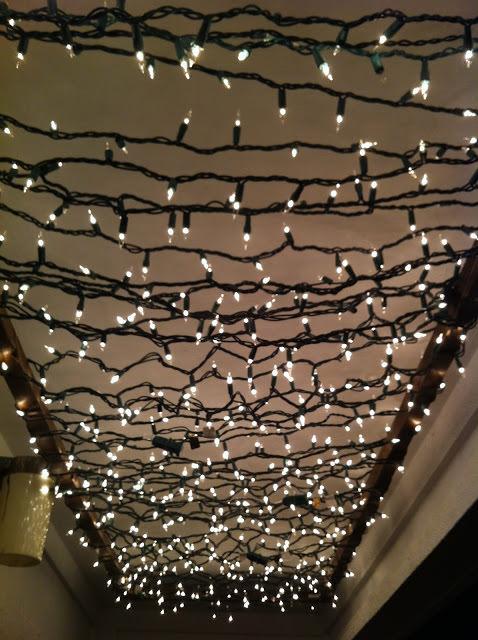
From The Project Table, this DIY icicle chandelier is made with simple twinkle lights and a grapevine wreath. Follow her instructions for an inexpensive but organic version of the hula hoop chandelier we see all over Pinterest. (Which we also love!)

The Budget Fashionista shows us how to make DIY outdoor pillows from vinyl table cloths or shower curtains! Love this!

This DIY metal tub coffee table by Liz Marie Blog is crazy cool! And while you are looking up the instructions on this project at her site, check out how inspiring her whole outdoor room is!

From Rachel at Thrifty Inspirations through 36th Ave… this amazing DIY outdoor sectional could solve that expensive outdoor furniture problem! She has full step by step instructions and links to the plans she used. Love this!

Need some more inspiration?
From BHG…build this DIY outdoor room in a weekend!

This pretty room from ‘Hayneedle‘ has been pinned thousands of times! Great inspiration, in collaboration with Brian Patrick Flynn!!

Last one, just to get you dreaming! Now get to creating your outdoor room!

0
0
文章
苍山洱海
2017年02月16日

If you love your cat, it’s a good idea to make an indoor cat garden for her. Just follow this step by step guide to do this!
If you’re like me who love her cats, you’ll surely approve of my idea of creating a CAT FRIENDLY GARDEN. Here I am mentioning about making an INDOOR CAT GARDEN.

As I love growing plants indoors, I always keep care when choosing plants– if they are safe for my kitty. So the first thing I suggest you for creating an indoor cat garden is to avoid growing plants that are toxic to a cat.
Avoid Growing Plants That Are Toxic To Cats
Grow cat safe plants, make a list of plants that are toxic to cats– When doing this, leave the plants that contain calcium oxalate as they don’t possess a threat and are mildly toxic. We also published a list of Plants that are toxic to dogs a while ago, take help of it. Again, you can exclude plants from your not growing list that contain ONLY calcium oxalate crystals like pothos, peace lily, philodendron or Chinese evergreen!
Many of our readers suggested through emails and comments that we should not label plants that contain calcium oxalate as toxic and we are in agreement.
Do research to find out what are the most poisonous plants for cats! Some plants that can be toxic to cats are the flame lily, tiger lily, azalea, sago palm, oleander, cyclamen, daffodils, etc.
Grow cat safe plants, plants that cats love to nibble
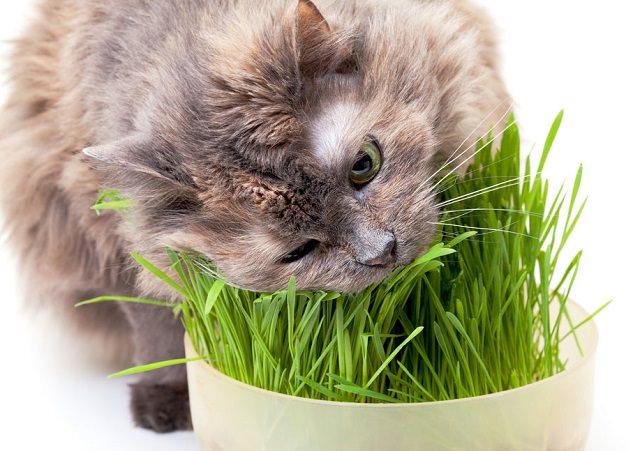
Cats love to play with plants and to bite them sometimes; you already know that! I have a few terracotta planters, broken; due to my cat’s mischief. If you too have broken pots, look at these DIY ideas. So, is not it a good idea to grow plants that your cat will love to nibble? It’s easy if you have a window that receives some sun you can create a Windowsill garden for your feline friend.
Here’re some plants to consider:

Valerian
Grow valerian. A medicinal herb, safe for cats. Most cats love rubbing, sniffing, and eating this plants and its healthy for them.
Catnip
Catnip is called catnip because cats like to nip it :P. Well, jokes apart, this edible herb contains an active ingredient called ‘Nepetalactone,’ this compound acts like a cat attractant.
Cat Grass
Cat grass is nothing but a mix of grasses– oat grass, wheat grass, rye grass, barley grass, orchard grass that cats love to gnaw on. You can grow them together in a wide container or window boxes. Learn how to grow Wheatgrass and its health benefits!
Mint
Grow mint family plants like spearmint, peppermint or any other type; it is not only safe for cats, but it also has many culinary uses, you and your feline both will love to smell this refreshing herb.

Lemongrass
Lemongrass is an exotic culinary and medicinal herb, and it releases fresh lemon like scent when crushed. The Pussycat rambling in your house will be very much interested in biting and smelling it. I also heard people saying it also deters mosquitoes but don’t know how much true it is!
Other Herbs
Also, these fours herbs rosemary, parsley, cilantro, and thyme are good for cats. You can create an indoor herb garden using them.
Scented Geranium
Scented geranium is a plant that your feline will love to sniff and rub against, it is perfectly safe for them. If you want to learn how to grow geranium indoors, click here!
Cat Thyme
Cat thyme only looks like original thyme, which is my most favorite herb. I dislike its musty odor and haven’t tried myself growing it for my cat. But it’s true that most of the cats love this plant.
Choose a right type of planter
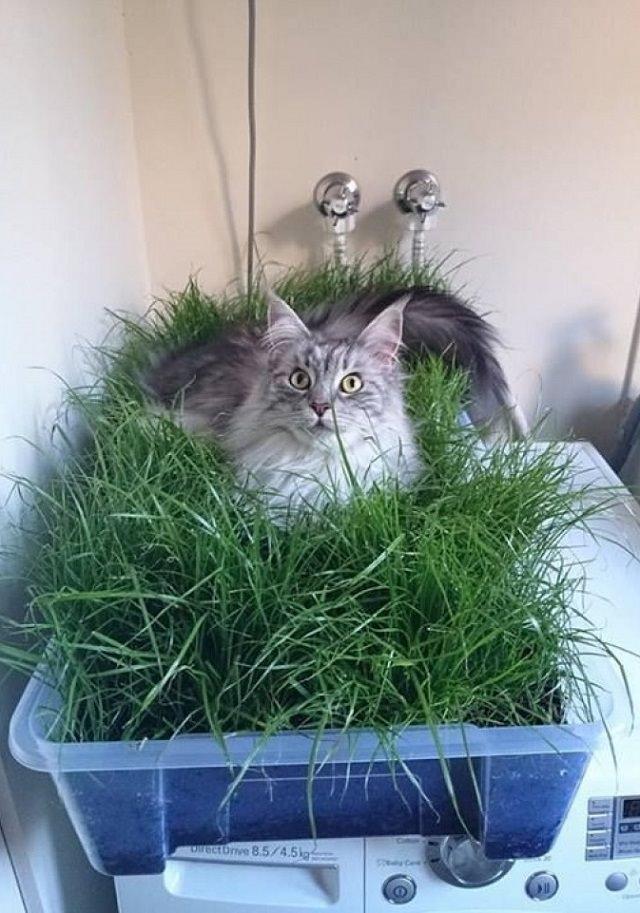
A planter that is wide and has space for your kitty to let her sit would be perfect. Wide planters are right; window boxes for example! Also, use sterilized soil to keep your pet safe.
If you’re like me who love her cats, you’ll surely approve of my idea of creating a CAT FRIENDLY GARDEN. Here I am mentioning about making an INDOOR CAT GARDEN.

As I love growing plants indoors, I always keep care when choosing plants– if they are safe for my kitty. So the first thing I suggest you for creating an indoor cat garden is to avoid growing plants that are toxic to a cat.
Avoid Growing Plants That Are Toxic To Cats
Grow cat safe plants, make a list of plants that are toxic to cats– When doing this, leave the plants that contain calcium oxalate as they don’t possess a threat and are mildly toxic. We also published a list of Plants that are toxic to dogs a while ago, take help of it. Again, you can exclude plants from your not growing list that contain ONLY calcium oxalate crystals like pothos, peace lily, philodendron or Chinese evergreen!
Many of our readers suggested through emails and comments that we should not label plants that contain calcium oxalate as toxic and we are in agreement.
Do research to find out what are the most poisonous plants for cats! Some plants that can be toxic to cats are the flame lily, tiger lily, azalea, sago palm, oleander, cyclamen, daffodils, etc.
Grow cat safe plants, plants that cats love to nibble

Cats love to play with plants and to bite them sometimes; you already know that! I have a few terracotta planters, broken; due to my cat’s mischief. If you too have broken pots, look at these DIY ideas. So, is not it a good idea to grow plants that your cat will love to nibble? It’s easy if you have a window that receives some sun you can create a Windowsill garden for your feline friend.
Here’re some plants to consider:

Valerian
Grow valerian. A medicinal herb, safe for cats. Most cats love rubbing, sniffing, and eating this plants and its healthy for them.
Catnip
Catnip is called catnip because cats like to nip it :P. Well, jokes apart, this edible herb contains an active ingredient called ‘Nepetalactone,’ this compound acts like a cat attractant.
Cat Grass
Cat grass is nothing but a mix of grasses– oat grass, wheat grass, rye grass, barley grass, orchard grass that cats love to gnaw on. You can grow them together in a wide container or window boxes. Learn how to grow Wheatgrass and its health benefits!
Mint
Grow mint family plants like spearmint, peppermint or any other type; it is not only safe for cats, but it also has many culinary uses, you and your feline both will love to smell this refreshing herb.

Lemongrass
Lemongrass is an exotic culinary and medicinal herb, and it releases fresh lemon like scent when crushed. The Pussycat rambling in your house will be very much interested in biting and smelling it. I also heard people saying it also deters mosquitoes but don’t know how much true it is!
Other Herbs
Also, these fours herbs rosemary, parsley, cilantro, and thyme are good for cats. You can create an indoor herb garden using them.
Scented Geranium
Scented geranium is a plant that your feline will love to sniff and rub against, it is perfectly safe for them. If you want to learn how to grow geranium indoors, click here!
Cat Thyme
Cat thyme only looks like original thyme, which is my most favorite herb. I dislike its musty odor and haven’t tried myself growing it for my cat. But it’s true that most of the cats love this plant.
Choose a right type of planter

A planter that is wide and has space for your kitty to let her sit would be perfect. Wide planters are right; window boxes for example! Also, use sterilized soil to keep your pet safe.
0
0
文章
Andy
2017年02月15日

Starting an indoor herb garden? Find out 11 best herbs to grow indoors. These are easiest to grow and require less care.
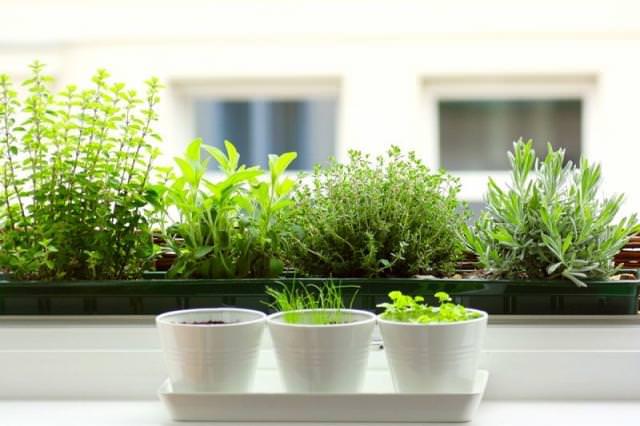
Best Herbs to Grow Indoors in Less Sun
1. Lemongrass
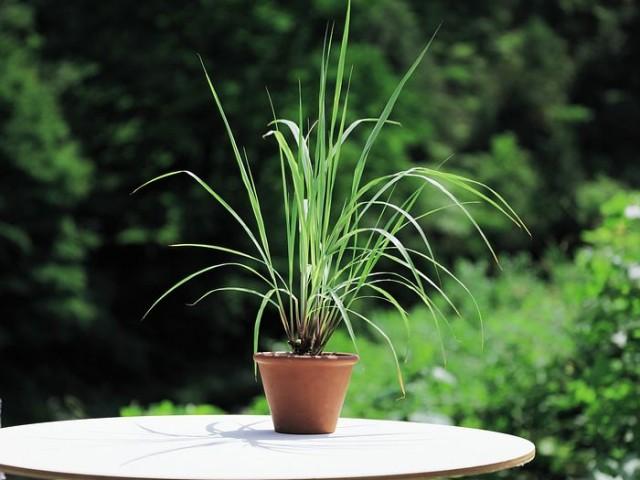
This herb grows wild in tropics and becomes easiest indoor herb, you can also grow it in temperate climates. It requires slightly moist soil and partial sun, and it can even adjust itself in a small container.
2. Mint
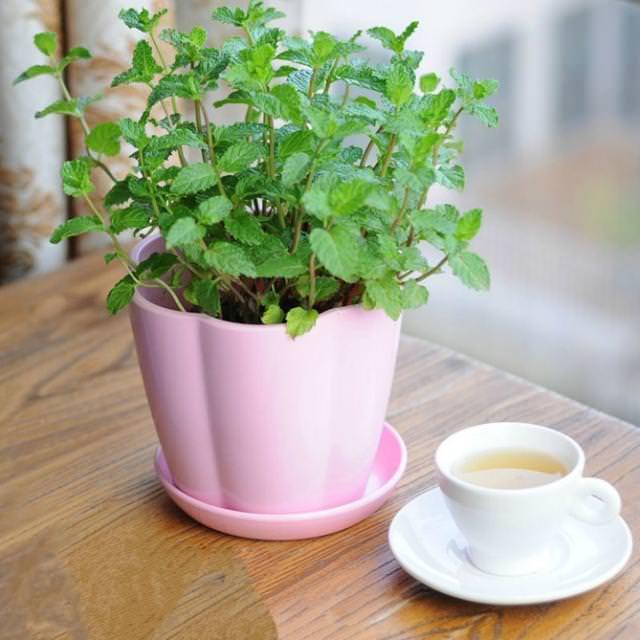
In the garden, mint becomes very invasive and grows like a weed. It doesn’t require plenty of sun too. You can even keep your potted mint plant in a spot that receives bright indirect sun.
3. Parsley

Germinate parsley from seeds, seedlings may sprout up late, sometimes in a month. But once grown, parsley requires minimal attention. Grow it in a medium-large pot and keep that in a spot that receives part sun. In a moderate room temperature, you can grow it year round. Just propagate new plants time to time from cuttings and it will last forever in your indoor herb garden.
4. Chives

Herbs that require less sunlight and moist soil in order to thrive are most suitable for growing indoors. Chives doesn’t require a sunny spot. Just place the pot near a bright window facing east. You can multiply chives from an already established plant by division.
5. Garden Cress

You can grow this cool season annual indoors easily. Plant seeds in a shallow but wide containers and keep the pot on a windowsill that receives partial sun. Soil should be moist, for regular harvest of cress micro greens, plant seeds in interval of every two weeks. You can cut and harvest the garden cress 3-4 times. If there is no sun, you can grow it under fluorescent lamps and T5 fluorescent plant lights.
6. Catnip
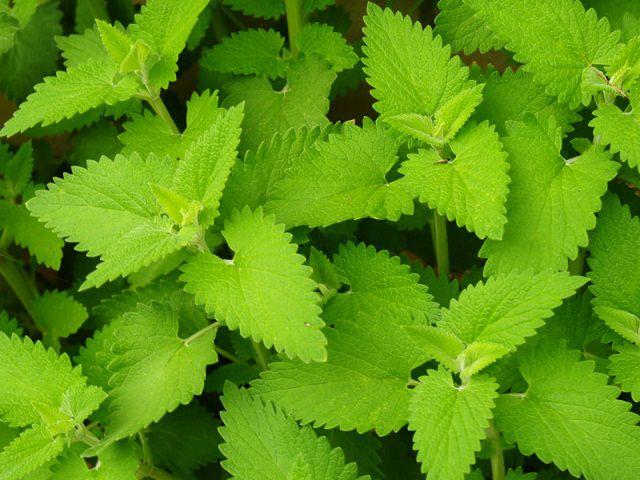
Growing catnip indoors is hard if you have cats. Apart from that, it is one of the easiest herbs. Once you germinate seeds, you can grow it forever from cuttings. Place the pot on a sunny windowsill and keep it well watered.
7. Lemon Balm

Lemon balm grows year round in warmer zones. Some gardeners even consider it a weed. Growing lemon balm indoors is super easy if you can provide it an exposure to 4 hours of sunlight daily. When growing indoors, water the plant only when top soil is dry.
8. Chervil
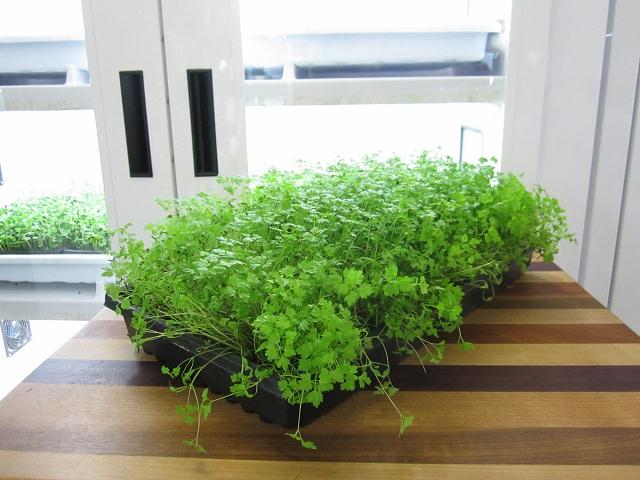
Chervil is one of the herbs you can grow indoors smoothly. A room temperature around 60-70 F is optimum for it. It can also adapt to low light conditions.
Best Herbs to Grow Indoors in More Sun9. Dill
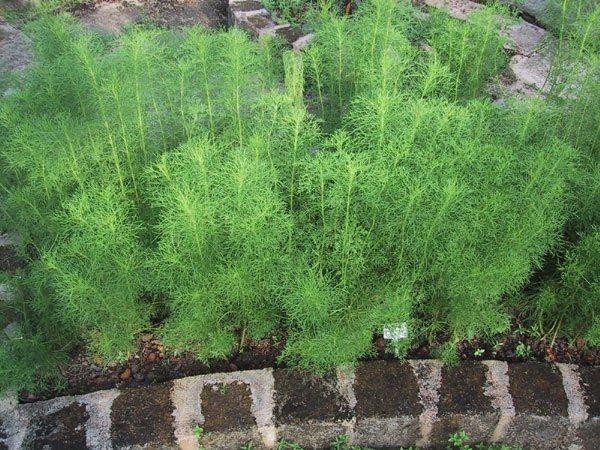
The secret of growing dill successfully in a container is to grow it in a deep one. A minimum 10 inches deep container is required. For growing dill indoors keep it in a spot that receives at least 5 hours of sunlight daily, provide good air circulation and water it only when top 1 inch surface of potting soil seems dry.
9. Cilantro

Image Credit: Gardening Know How
Cilantro is extremely easy to germinate but hard to maintain in containers. The trick is to grow cilantro in a deep container. It bolts quickly so it is better to plant seeds time to time. Keep cilantro in the south or west facing window.
10. Sage
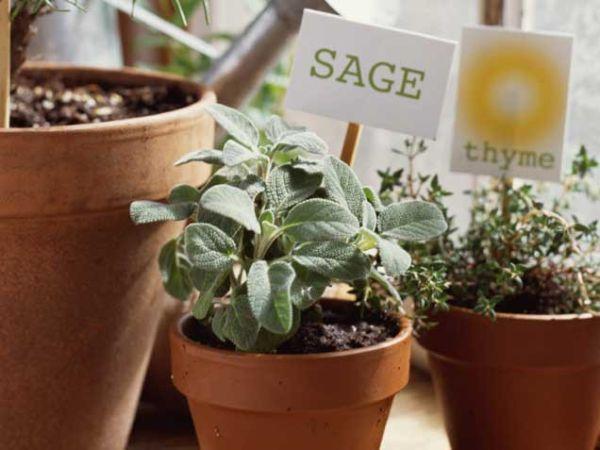
Grow sage indoors only if you have a South or West facing window that receives plenty of sun. This perennial herb takes a lot of time to get established when grown from seeds so it is better to take a tip cutting and propagate it.
11. Thyme
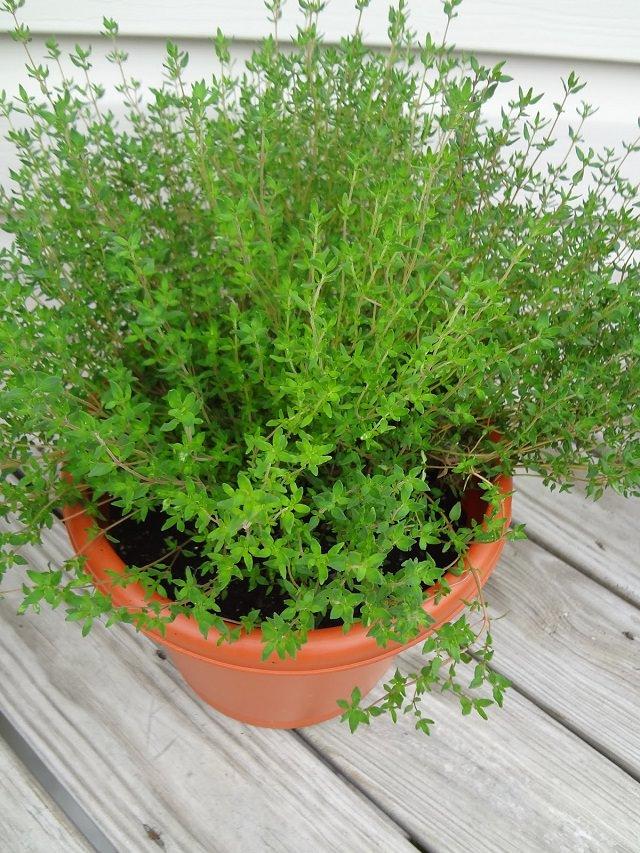
Thyme can adjust itself to partial sun and if you can provide 5 hours of sunlight daily, growing thyme indoors is possible.
A few more herbs you can grow indoors on a sunny windowsillOreganoRosemaryTarragonBasil

Best Herbs to Grow Indoors in Less Sun
1. Lemongrass

This herb grows wild in tropics and becomes easiest indoor herb, you can also grow it in temperate climates. It requires slightly moist soil and partial sun, and it can even adjust itself in a small container.
2. Mint

In the garden, mint becomes very invasive and grows like a weed. It doesn’t require plenty of sun too. You can even keep your potted mint plant in a spot that receives bright indirect sun.
3. Parsley

Germinate parsley from seeds, seedlings may sprout up late, sometimes in a month. But once grown, parsley requires minimal attention. Grow it in a medium-large pot and keep that in a spot that receives part sun. In a moderate room temperature, you can grow it year round. Just propagate new plants time to time from cuttings and it will last forever in your indoor herb garden.
4. Chives

Herbs that require less sunlight and moist soil in order to thrive are most suitable for growing indoors. Chives doesn’t require a sunny spot. Just place the pot near a bright window facing east. You can multiply chives from an already established plant by division.
5. Garden Cress

You can grow this cool season annual indoors easily. Plant seeds in a shallow but wide containers and keep the pot on a windowsill that receives partial sun. Soil should be moist, for regular harvest of cress micro greens, plant seeds in interval of every two weeks. You can cut and harvest the garden cress 3-4 times. If there is no sun, you can grow it under fluorescent lamps and T5 fluorescent plant lights.
6. Catnip

Growing catnip indoors is hard if you have cats. Apart from that, it is one of the easiest herbs. Once you germinate seeds, you can grow it forever from cuttings. Place the pot on a sunny windowsill and keep it well watered.
7. Lemon Balm

Lemon balm grows year round in warmer zones. Some gardeners even consider it a weed. Growing lemon balm indoors is super easy if you can provide it an exposure to 4 hours of sunlight daily. When growing indoors, water the plant only when top soil is dry.
8. Chervil

Chervil is one of the herbs you can grow indoors smoothly. A room temperature around 60-70 F is optimum for it. It can also adapt to low light conditions.
Best Herbs to Grow Indoors in More Sun9. Dill

The secret of growing dill successfully in a container is to grow it in a deep one. A minimum 10 inches deep container is required. For growing dill indoors keep it in a spot that receives at least 5 hours of sunlight daily, provide good air circulation and water it only when top 1 inch surface of potting soil seems dry.
9. Cilantro

Image Credit: Gardening Know How
Cilantro is extremely easy to germinate but hard to maintain in containers. The trick is to grow cilantro in a deep container. It bolts quickly so it is better to plant seeds time to time. Keep cilantro in the south or west facing window.
10. Sage

Grow sage indoors only if you have a South or West facing window that receives plenty of sun. This perennial herb takes a lot of time to get established when grown from seeds so it is better to take a tip cutting and propagate it.
11. Thyme

Thyme can adjust itself to partial sun and if you can provide 5 hours of sunlight daily, growing thyme indoors is possible.
A few more herbs you can grow indoors on a sunny windowsillOreganoRosemaryTarragonBasil
4
1
文章
Andy
2017年02月15日

Want to grow an Indoor Herb Garden? Learn everything you need to know in these 7 INFOGRAPHICS that’ll teach you everything about growing herbs indoors.
Growing an indoor herb garden is the best way to grow your own herbs if you don’t have space outdoors.
1. Growing Herbs From Seeds

Starting herb seeds successfully either indoor or outdoor requires a number of things including ample light, quality growing medium, moisture, the right temperature, air circulation, and the MOST important thing– lots of patience. Save and use the infographic given above to learn how to start herb seeds.
2. Herb Planting Tips

Use this infographic to learn about a few basic herb planting tips.
3. How To Grow Your Own Indoor Herb Garden

Source: Chadwicks
If you live in an apartment the best way to always have fresh herbs is to make your very own indoor herb garden or if you have a balcony you can create a Balcony Herb Garden. Also, Chadwicks have put together this perfect infographic to help you successfully grow your own indoor herb garden.
4. Light Requirements Of Indoor Herbs

Source: The Growers Exchange
Check out this comprehensive infographic on light requirements of indoor herbs. This infographic will help you ensure that your indoor herbs are receiving proper amount of light so that you’ll get bountiful and flavourful harvest.
5. Easiest Herbs To Grow Indoors

Source: Desima
If you are just beginning with indoor herb gardening it is worth to grow easiest herbs first to ensure successful harvest. This great infographic will help you in choosing the easiest herbs to grow.
6. Guide To Flavoring With Herbs

Source: Cooksmarts
This infographic is about storing and using herbs in cooking. To help you get cooking with herbs and learn how to keep them fresh, take help of this infographic. It will tell you all about herbs and their flavors, when to use fresh herbs and dried herbs and how to properly store them so that they’ll last longer.
7. How To Create A Windowsill Herb Garden

Source: TheTruthAboutCancer
This inforgraphic is about the herbs you can grow on the windowsill, to learn more you can read our guide on Windowsill Herb Gardening.
Growing an indoor herb garden is the best way to grow your own herbs if you don’t have space outdoors.
1. Growing Herbs From Seeds

Starting herb seeds successfully either indoor or outdoor requires a number of things including ample light, quality growing medium, moisture, the right temperature, air circulation, and the MOST important thing– lots of patience. Save and use the infographic given above to learn how to start herb seeds.
2. Herb Planting Tips

Use this infographic to learn about a few basic herb planting tips.
3. How To Grow Your Own Indoor Herb Garden

Source: Chadwicks
If you live in an apartment the best way to always have fresh herbs is to make your very own indoor herb garden or if you have a balcony you can create a Balcony Herb Garden. Also, Chadwicks have put together this perfect infographic to help you successfully grow your own indoor herb garden.
4. Light Requirements Of Indoor Herbs

Source: The Growers Exchange
Check out this comprehensive infographic on light requirements of indoor herbs. This infographic will help you ensure that your indoor herbs are receiving proper amount of light so that you’ll get bountiful and flavourful harvest.
5. Easiest Herbs To Grow Indoors

Source: Desima
If you are just beginning with indoor herb gardening it is worth to grow easiest herbs first to ensure successful harvest. This great infographic will help you in choosing the easiest herbs to grow.
6. Guide To Flavoring With Herbs

Source: Cooksmarts
This infographic is about storing and using herbs in cooking. To help you get cooking with herbs and learn how to keep them fresh, take help of this infographic. It will tell you all about herbs and their flavors, when to use fresh herbs and dried herbs and how to properly store them so that they’ll last longer.
7. How To Create A Windowsill Herb Garden

Source: TheTruthAboutCancer
This inforgraphic is about the herbs you can grow on the windowsill, to learn more you can read our guide on Windowsill Herb Gardening.
2
1
文章
Andy
2017年02月14日

Get inspired by following these 24 Indoor Herb Garden Ideas we’ve collected from around the web, click on the links given below to see the images and tutorials that you like to know about.
Nothing beats a few sprigs of fresh herbs straight from the planter itself. But if you are short of outdoor space or have weather conditions that discourage you. Make an indoor herb garden.
Indoor Herb Garden Ideas
1. TeaCup Herb Garden

Grow a herb garden in vintage teacups that you no longer use. Not only it will look good but this way you will be able to grow your own herbs. Learn how to make a teacup planter here!
via: TheBowerbirdstories
Also Read: Best Tea Herbs
2. Hanging Herb Garden

Create a hanging Herb Garden on each window with hooks, drinking glasses and metal wire.
via: Its Bits and Pieces
Also Read: Growing Strawberry Upside Down
3. Kitchen Utensil Herb Garden

Give a Second Life to your old metal boiler or other kitchen utensils as a planter for your kitchen herb garden.
via: funkyjunkinteriors
Also Read: How to Start a Container Kitchen Garden
4. Tea Can Herb Garden

Have empty tea cans? Use them grow herbs.
via: apartment therapy , make good studio
5. Mason Jar Herb Garden

Every home has mason jars why not grow an indoor herb garden in them.
via: eighteen25
6. Pallet Herb Garden

Make a hanging Indoor Vertical Garden with recycled pallets. Besides this, there are so many things you can do with pallets, read our post to find out.
via: beersnbeans
7. Wooden Crates Herb Garden

Have old wooden crates? Follow this idea. This is the most amazing way to use old crates.
via: williamssonoma
8. Hanging Mason Jar Herb Garden

Beautiful and functional. All you need for this DIY is some mason jars and a wooden board.
via Camille Styles
9. Hanging Vertical Herb Garden

Small, painted cans are perfect for growing herbs. Paint them in whatever colors suit your style.
via: Upcycledstuff
Also Read: DIY Pot Decoration Ideas
10. Tiered Herb Garden

Don’t have enough space to place the pots? Make this tired herb garden.
via: Fancyfrugallife
Also Read: Edible Plants that Grow in Shade
11. DIY Herb Shelf

Not only does this herb shelf uses your vertical space into a beautiful and productive potted garden, but it’s also a rather an easy-to-make project. Follow the link below to find out how to make it.
via: Ben Uyeda
Also Read: Apartment Balcony Decoration Ideas
12. Wine Bottle Holder Herb Garden

Mount an Ikea wine holder horizontally and plant your herbs into pint glasses.
via Curbly
13. Clothespin Herb Planter

This project is simply done with old tuna cans (paint that if desired), with stained wood clothespins clipped onto the edges of the can. You can get these old style clothespins at the dollar store or online.
via 7thhouseontheleft
Also Read: How to Grow Lemon Tree in a Pot
14. Drawer Herb Garden

Has an unused drawer lain around? Turn it into your very own herb garden. Just insert some pots and/or lining and you’re all set.
Also Read: DIY Ladder Shelf
via Thegardenglove
15. Pallet Rack Herb Garden

An eye-catcher: Pallet rack with herbs in the jute bag.
Also Read: Make Things Out of Twigs and Branches
16. Countertop Tin Can Herb Garden

If you have some space on your counter, you can make this adorable tin can garden. Keep your cans together and allow for drainage in a circular pan or tray. It’s easy and environment-friendly.
via HGTV
17. Rain Gutter Herb Garden

Repurpose rain gutters into an easy indoor herb garden.
via 1001gardens
Also Read: Growing Strawberry in Gutters
18. Shoe Bag Herb Garden

Make this herb garden in a shoe bag that you can easily hang indoors. Handy, if you don’t have a garden.
via Culy
Also Read: Windowsill Herb Garden
19. Wall Decoration Herb Garden

Make this sweet herb garden with a vintage look with old jam jars and a wooden board.
via Miss
Also Read: Growing Dill in Tropics
20. Self Watering Bottle Garden

Although this project may take a little more effort than some of those given above but its payoff is worth it: Such a good way to recycle bottles and getting fresh herbs and a sparkling window display.
via Designsponge
Also Read: How to Water Container Plants
21. Upside Down Herb Garden

Now a fancy way of growing herbs. Try this space saving idea, hang herbs upside down in your kitchen and harvest them whenever needed.
via Apartment Therapy
Also Read: Growing Tomatoes in Hanging Basket
22. Hanging Jars Herb Garden

Make this colorful herb garden with metal chains, mason jars and hooks.
via Bugaboominimrme
23. Indoor Garden Wall

Easy and incredible. With just some little tin buckets, picture hangers, and your plants, you’ll have this beautiful display up in no time.
via Tenjuneblog
Also Read: Indoor Plants according to Different Light Conditions
Nothing beats a few sprigs of fresh herbs straight from the planter itself. But if you are short of outdoor space or have weather conditions that discourage you. Make an indoor herb garden.
Indoor Herb Garden Ideas
1. TeaCup Herb Garden

Grow a herb garden in vintage teacups that you no longer use. Not only it will look good but this way you will be able to grow your own herbs. Learn how to make a teacup planter here!
via: TheBowerbirdstories
Also Read: Best Tea Herbs
2. Hanging Herb Garden

Create a hanging Herb Garden on each window with hooks, drinking glasses and metal wire.
via: Its Bits and Pieces
Also Read: Growing Strawberry Upside Down
3. Kitchen Utensil Herb Garden

Give a Second Life to your old metal boiler or other kitchen utensils as a planter for your kitchen herb garden.
via: funkyjunkinteriors
Also Read: How to Start a Container Kitchen Garden
4. Tea Can Herb Garden

Have empty tea cans? Use them grow herbs.
via: apartment therapy , make good studio
5. Mason Jar Herb Garden

Every home has mason jars why not grow an indoor herb garden in them.
via: eighteen25
6. Pallet Herb Garden

Make a hanging Indoor Vertical Garden with recycled pallets. Besides this, there are so many things you can do with pallets, read our post to find out.
via: beersnbeans
7. Wooden Crates Herb Garden

Have old wooden crates? Follow this idea. This is the most amazing way to use old crates.
via: williamssonoma
8. Hanging Mason Jar Herb Garden

Beautiful and functional. All you need for this DIY is some mason jars and a wooden board.
via Camille Styles
9. Hanging Vertical Herb Garden

Small, painted cans are perfect for growing herbs. Paint them in whatever colors suit your style.
via: Upcycledstuff
Also Read: DIY Pot Decoration Ideas
10. Tiered Herb Garden

Don’t have enough space to place the pots? Make this tired herb garden.
via: Fancyfrugallife
Also Read: Edible Plants that Grow in Shade
11. DIY Herb Shelf

Not only does this herb shelf uses your vertical space into a beautiful and productive potted garden, but it’s also a rather an easy-to-make project. Follow the link below to find out how to make it.
via: Ben Uyeda
Also Read: Apartment Balcony Decoration Ideas
12. Wine Bottle Holder Herb Garden

Mount an Ikea wine holder horizontally and plant your herbs into pint glasses.
via Curbly
13. Clothespin Herb Planter

This project is simply done with old tuna cans (paint that if desired), with stained wood clothespins clipped onto the edges of the can. You can get these old style clothespins at the dollar store or online.
via 7thhouseontheleft
Also Read: How to Grow Lemon Tree in a Pot
14. Drawer Herb Garden

Has an unused drawer lain around? Turn it into your very own herb garden. Just insert some pots and/or lining and you’re all set.
Also Read: DIY Ladder Shelf
via Thegardenglove
15. Pallet Rack Herb Garden

An eye-catcher: Pallet rack with herbs in the jute bag.
Also Read: Make Things Out of Twigs and Branches
16. Countertop Tin Can Herb Garden

If you have some space on your counter, you can make this adorable tin can garden. Keep your cans together and allow for drainage in a circular pan or tray. It’s easy and environment-friendly.
via HGTV
17. Rain Gutter Herb Garden

Repurpose rain gutters into an easy indoor herb garden.
via 1001gardens
Also Read: Growing Strawberry in Gutters
18. Shoe Bag Herb Garden

Make this herb garden in a shoe bag that you can easily hang indoors. Handy, if you don’t have a garden.
via Culy
Also Read: Windowsill Herb Garden
19. Wall Decoration Herb Garden

Make this sweet herb garden with a vintage look with old jam jars and a wooden board.
via Miss
Also Read: Growing Dill in Tropics
20. Self Watering Bottle Garden

Although this project may take a little more effort than some of those given above but its payoff is worth it: Such a good way to recycle bottles and getting fresh herbs and a sparkling window display.
via Designsponge
Also Read: How to Water Container Plants
21. Upside Down Herb Garden

Now a fancy way of growing herbs. Try this space saving idea, hang herbs upside down in your kitchen and harvest them whenever needed.
via Apartment Therapy
Also Read: Growing Tomatoes in Hanging Basket
22. Hanging Jars Herb Garden

Make this colorful herb garden with metal chains, mason jars and hooks.
via Bugaboominimrme
23. Indoor Garden Wall

Easy and incredible. With just some little tin buckets, picture hangers, and your plants, you’ll have this beautiful display up in no time.
via Tenjuneblog
Also Read: Indoor Plants according to Different Light Conditions
3
0




